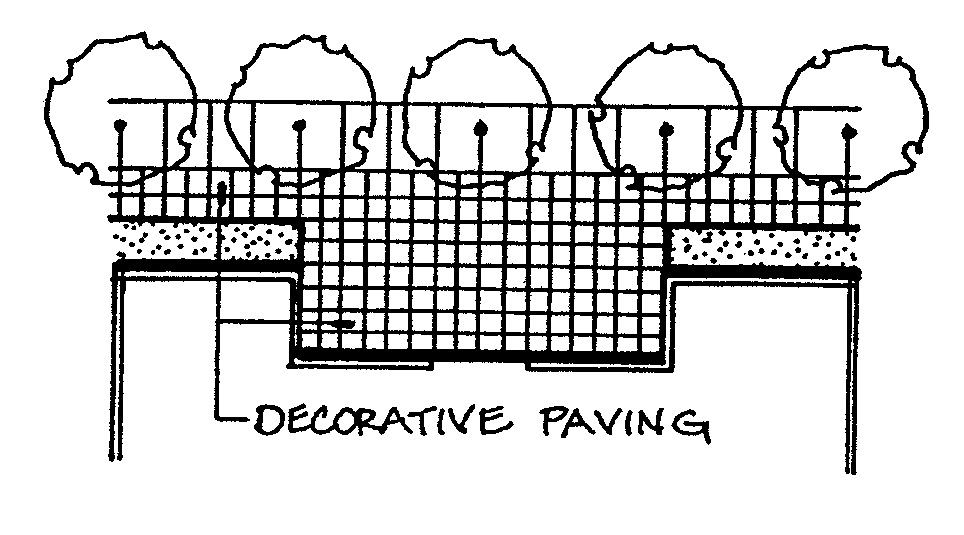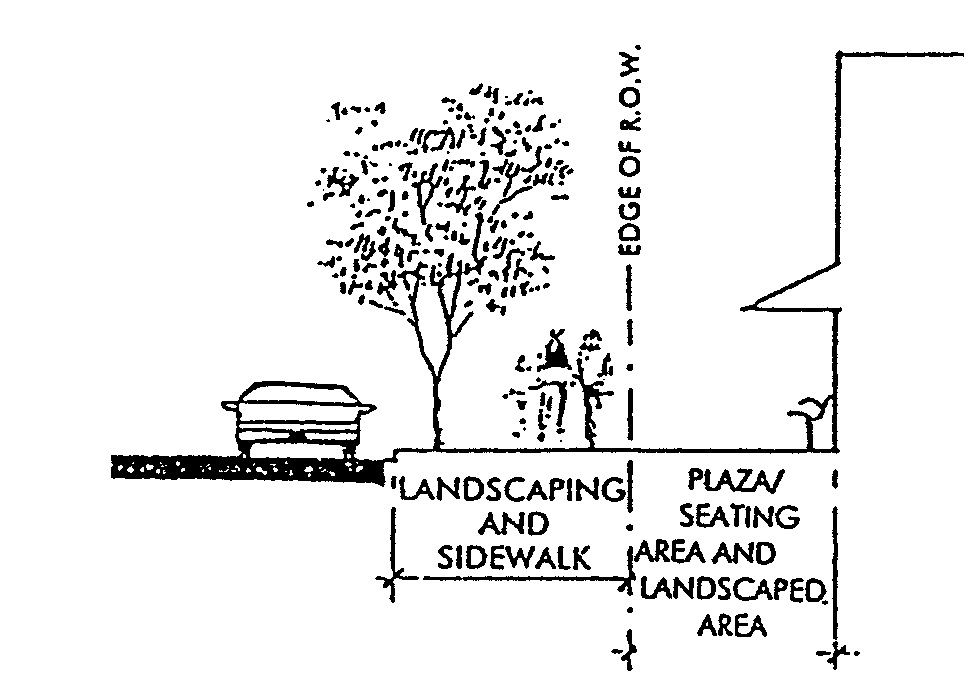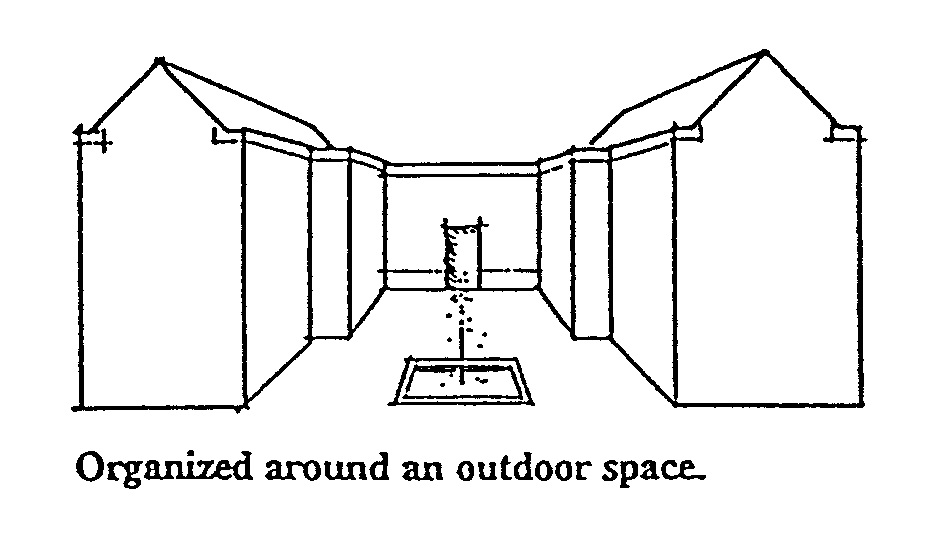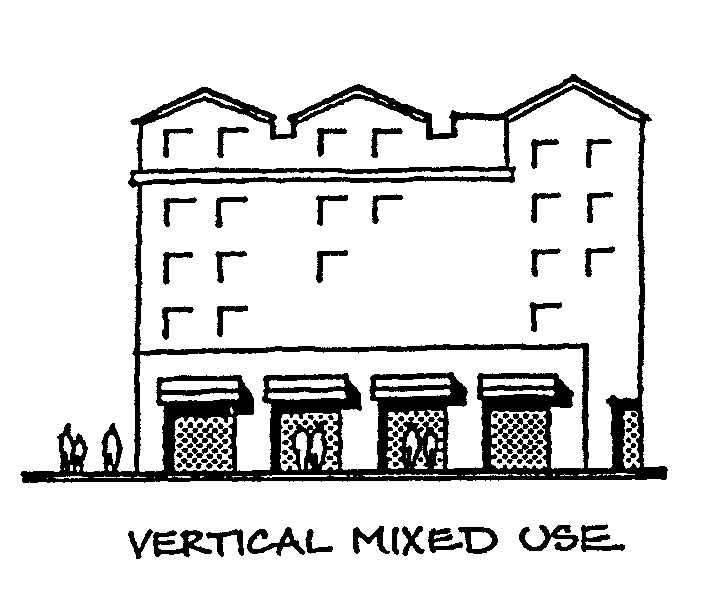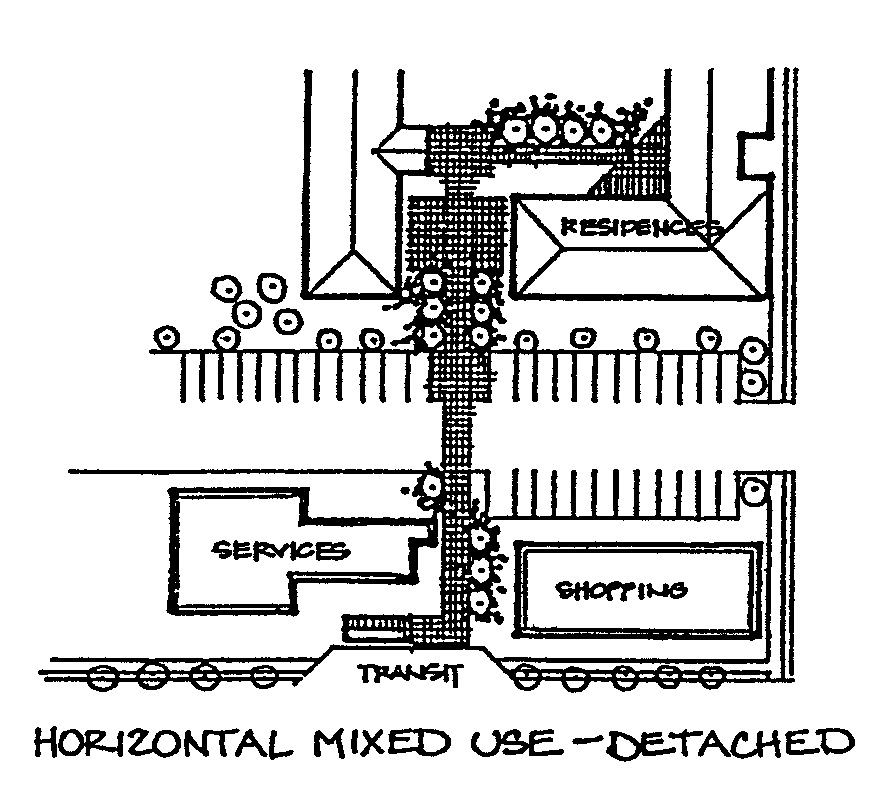Division III. Overlay Districts and Zones
Chapters:
15.300 City Center Overlay District
15.305 South 154th Street Station Area Overlay District
15.310 Angle Lake Station Area Overlay District
Chapter 15.300
City Center Overlay District
Sections:
15.300.010 Authority and Application
15.300.055 City Center Overlay District Use Chart
15.300.110 Vehicular Circulation Requirements
15.300.120 Pedestrian Circulation Requirements
15.300.200 Site Planning and Building Orientation
15.300.210 Building Placement/Setbacks
15.300.220 Development Abutting Two (2) or More Street Frontages
15.300.230 Relation to Adjacent Development
15.300.240 Projects on or Near the Edge of a UL or UM Residential Zone
15.300.250 The Layout and Width of Streetfront Pedestrian Zone
15.300.270 Location of Drive-Through Stacking Lanes
15.300.300 Open Space and Amenities
15.300.310 Minimum Open Space Area Required
15.300.320 Front Yard Open Space
15.300.325 Incorporating Bow Lake as a Focal Point
15.300.330 Alternative Methods for Meeting Open Space Requirement
15.300.340 Open Space Design Standards
15.300.410 Off-Street Parking Requirements and Reductions
15.300.420 Off-Street Loading Requirements
15.300.440 General Parking Design and Construction Standards
15.300.500 Landscaping Standards
15.300.610 Street Level Design
15.300.620 Pedestrian Building Entries
15.300.640 Rooflines and Equipment
15.300.700 Mixed Use and Multi-Family Development Standards
15.300.710 Mixed Use Development Standards
15.300.720 Definition of Mixed Use
15.300.730 Ground Floor Uses in Mixed Use Projects
15.300.740 Multi-Family Development Standards
15.300.800 Additional Standards
15.300.900 Development Incentives
15.300.005 Purpose
A. The following standards are intended to implement the City’s vision for a City Center/central business district as set forth in the City of SeaTac Comprehensive Plan, by promoting integrated development and pedestrian-oriented design, a diversity of uses within close proximity, a linked series of open spaces, and a focal point for community identity.
B. Each standard includes examples and illustrations of ways in which the intent of the standard could be achieved. The graphic illustrations are meant to be examples, and not the only acceptable means to accomplishing the intent of the illustrated standards. Applicants and project designers are encouraged to consider designs, styles and techniques not pictured in the examples that fulfill the intent of the design standard. (Ord. 15-1018 § 1)
15.300.010 Authority and Application
A. The provisions of this chapter shall apply to the City Center Overlay District as delineated in the City Center Overlay District Map at the end of this section. Within the City Center Overlay District, this chapter shall supersede existing regulations elsewhere in SMC Title 15 when in conflict with this chapter.
B. The provisions of this chapter shall apply to all development meeting one (1) or more of the following thresholds:
1. All new construction requiring building permits; and/or
2. Major Redevelopment. Additions or alterations to a building or site, excluding interior-only improvements, which total fifty percent (50%) or more of the gross square footage (GSF) of the existing building(s) or site.
Only the portions of the building or site being altered or added to shall be required to integrate City Center Overlay District standards into the design of the alteration or addition. Project applicants proposing additions or alterations to a building or site conforming to the above criteria for major redevelopment shall arrange a pre-design meeting with planning staff prior to permit application to establish those design standards applicable to the proposed addition or alteration.
C. Departures. In order to provide flexibility and creativity of project designs, departures from these overlay district standards may be permitted (except to maximum parking requirements in SMC 15.300.410, Off-Street Parking Requirements and Reductions, and SMC 15.300.950, Parking Bonus Incentive Program for Structured Public/Private Parking), subject to the approval of the Director.
1. If the strict interpretation or application of these special standards would be inconsistent with related provisions of the Zoning Code or would be contrary to the overall purpose or intent of City goals and objectives for the City Center Overlay District or Comprehensive Plan; or
2. If it can be shown that the overall project design and feasibility can be improved.
D. Development Agreements. In order to provide flexibility, to permit creativity of design, style, and technique, and to provide for phased development and interim uses, development agreements may be entered into by and between the City and property owners or developers, pursuant to RCW 36.70B.170 through 36.70B.200; provided, that the terms of any such development agreement shall be consistent with the purpose and intent of this chapter. Special conditions or exemptions established for a particular site or project through a development agreement shall include criteria or date for the termination of any such agreement.
E. Single-Family Exemption. Single-family homes are exempt from the provisions of this chapter. In addition, the following zoning designation and related land uses are exempt from the provisions of this chapter: Urban Low (UL).
F. High Capacity Transit Facilities. Standards for high capacity transit facilities, as identified in Chapter 15.530 SMC, High Capacity Transit Facilities Design Standards, shall apply to all applicable development within the City Center Overlay District.
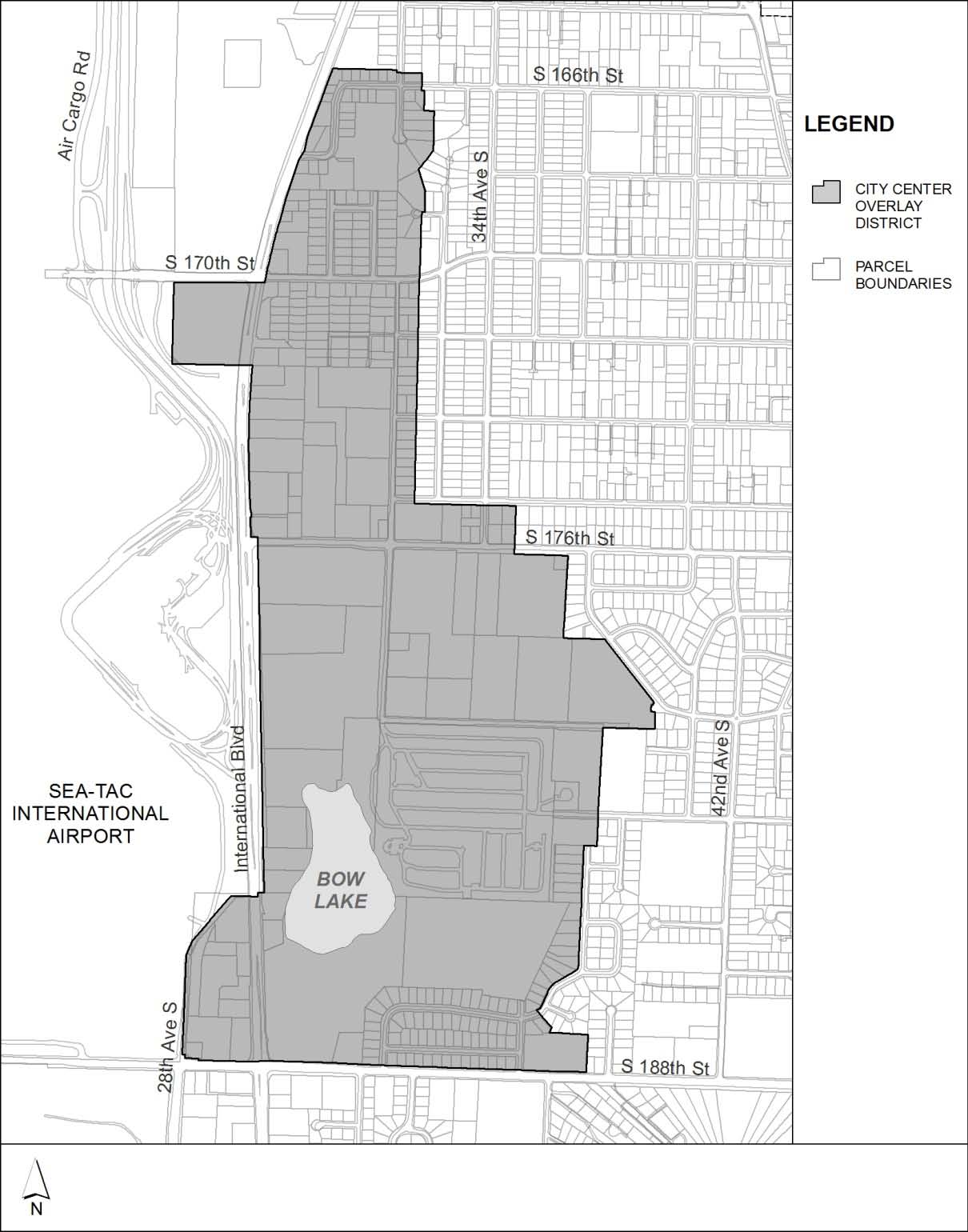
Figure: CITY CENTER OVERLAY DISTRICT MAP
(Ord. 15-1018 § 1)
15.300.050 Use Chart
A. Use Chart Guide.
1. About the Use Chart. The following chart lists all of the permitted and conditional land uses allowed in each zone.
2. How to Use the Use Chart. The land uses are listed vertically along the left hand side and the zones are listed horizontally across the top. Each square in the chart shows the following possibilities for the use and the zone:
P: The use is permitted.
C: The use is allowed subject to a conditional use permit.
If the square is blank, the use is not permitted in that zone.
3. Additional Standards According to Use. Additional standards that apply to a particular use and zone are noted by number and described in the column on the far right of the chart. If the standard is not preceded by a number, the standard applies to all zones. (Ord. 15-1018 § 1)
15.300.055 City Center Overlay District Use Chart
|
ZONES: |
|
|
UM – Urban Medium |
O/CM – Office/Commercial Medium |
|
UH – Urban High |
O/C/MU – Office/Commercial/Mixed Use |
|
UH-UCR – Urban High-Urban Center Residential |
T – Townhouse |
|
NB – Neighborhood Business |
P – Park |
|
CB-C – Community Business in the Urban Center |
|
|
P – Permitted Use; C – Conditional Use Permit required |
|
|
LAND USE |
UM |
UH |
UH-UCR |
NB |
CB-C |
O/CM |
O/C/MU |
T |
P |
Additional Regulations |
|---|---|---|---|---|---|---|---|---|---|---|
|
ANIMALS |
||||||||||
|
Kennel/Cattery |
|
|
|
P |
P(1) |
|
|
|
|
(1) Permitted as accessory to primary use not to exceed 20% of total square footage of building(s). |
|
Stables |
|
|
|
|
|
|
|
|
P |
|
|
Veterinary Clinic |
|
|
P(1) |
P |
P |
P(1) |
C |
|
|
(1) Permitted as a part of a mixed use development, as described in SMC 15.300.720, Definition of Mixed Use. |
|
BUSINESS SERVICES |
||||||||||
|
Airport Support Facility |
|
|
|
|
|
|
|
|
|
|
|
Commercial/Industrial Accessory Uses |
|
|
|
P |
C |
C |
|
|
|
|
|
Conference/Convention Center |
|
|
|
P |
P |
P |
|
|
|
|
|
Construction/Trade |
|
|
|
|
C |
C |
|
|
|
|
|
Distribution Center/Warehouse |
|
|
|
C |
|
C(1) |
|
|
|
(1) Permitted as accessory to primary use not to exceed 20% of total square footage of building(s). |
|
Equipment Rental, Large |
|
|
|
|
|
|
|
|
|
|
|
Equipment Rental, Small |
|
|
|
C |
C |
P(1) |
|
|
|
(1) Permitted as accessory to primary use not to exceed 20% of total square footage of building(s). |
|
Equipment Repair, Large |
|
|
|
|
|
|
|
|
|
|
|
Equipment Repair, Small |
|
|
|
P |
P(1) |
P(2) |
|
|
|
(1) Permitted as accessory to primary use not to exceed 20% of total square footage of building(s). (2) Permitted as a part of a mixed use development, as described in SMC 15.300.720, Definition of Mixed Use. |
|
Helipad/Airport and Facilities |
|
|
|
|
|
|
|
|
|
|
|
Professional Office |
|
P(1) |
P(1) |
P |
P |
P |
P |
|
|
(1) Permitted as a part of a mixed use development, as described in SMC 15.300.720, Definition of Mixed Use. |
|
Storage, Self-Service |
|
|
|
|
|
|
|
|
|
|
|
Truck Terminal |
|
|
|
|
|
|
|
|
|
|
|
CIVIC AND INSTITUTIONAL |
||||||||||
|
Cemetery |
C |
C |
|
C |
C |
|
|
|
C |
|
|
City Hall |
|
|
P(1) |
P |
P |
|
|
|
|
(1) Permitted as a part of a mixed use development, as described in SMC 15.300.720, Definition of Mixed Use. |
|
Court |
|
|
|
|
P |
P |
P |
|
|
|
|
Fire Facility |
P |
P |
P |
P |
P |
P |
P |
|
P |
|
|
Funeral Home/Crematory |
|
|
|
P |
P(1) |
P(2) |
|
|
C |
(1) Permitted as accessory to primary use not to exceed 20% of total square footage of building(s). (2) Permitted as a part of a mixed use development, as described in SMC 15.300.720, Definition of Mixed Use. |
|
Police Facility |
P |
P |
P |
P |
P |
P |
P |
|
P |
|
|
Public Agency Office |
|
P |
P |
P |
P |
P |
P |
|
P |
|
|
Public Agency Yard |
|
|
|
|
C |
C |
C |
|
C(1) |
(1) A public agency yard located on property within the park zone may be used as a combined maintenance facility for park and nonpark purposes; provided, that the facility shall be no more expansive than that which is reasonably expected to be needed for park maintenance when park facilities are fully developed. |
|
Public Archives |
|
|
|
C |
P |
P |
P |
|
C(1) |
(1) A public archives facility located on property within the park zone is limited to existing structures. |
|
Social Service Office |
|
C |
P |
P |
P |
P |
P |
|
|
|
|
EDUCATIONAL |
||||||||||
|
College/University |
C |
C |
C |
|
P |
P |
P(1) |
|
|
(1) Permitted as a part of a mixed use development, as described in SMC 15.300.720, Definition of Mixed Use. |
|
Elementary/Middle School |
C |
C |
C |
|
|
|
|
|
|
|
|
High School |
C |
C |
C |
P |
C |
|
|
|
|
|
|
Specialized Instruction School |
P(1) |
P(1) |
P |
P |
P |
P(2) |
P(2) |
|
|
(1) Limited to 3 students per day. (2) Permitted as a part of a mixed use development, as described in SMC 15.300.720, Definition of Mixed Use. |
|
Vocational/Technical School |
|
|
|
C |
P |
P(1) |
P(1) |
|
|
(1) Permitted as a part of a mixed use development, as described in SMC 15.300.720, Definition of Mixed Use. |
|
HEALTH AND HUMAN SERVICES |
||||||||||
|
Day Care I |
P(1) |
P(1) |
P(1) |
P(1) |
|
P(1,2) |
P(1,2) |
P(1) |
|
See Chapter 15.420 SMC, Day Care Facilities. (1) If family day care providing in-home care, regulations in SMC 15.420.200, Family Day Care Facilities apply. (2) Permitted as a part of a mixed use development, as described in SMC 15.300.720, Definition of Mixed Use. |
|
Day Care II |
P |
P |
P |
P |
P |
P(1) |
P(1) |
|
|
See Chapter 15.420 SMC, Day Care Facilities. (1) Permitted as a part of a mixed use development, as described in SMC 15.300.720, Definition of Mixed Use. |
|
Emergency Housing |
P(1) |
P(1)/C(2) |
P(1)/C(2) |
P(1)/C(2) |
P(1)/C(2) |
P(1)/C(2) |
P(1)/C(2) |
P(1) |
|
(1) Allowed only as part of permitted religious use facility accessory not to exceed 20% of total building square footage, providing operating plan is approved ensuring there are no significant traffic or noise impacts to neighbors, and that health and safety standards are met. (2) See SMC 15.465.350, Supportive Housing Facilities Standards. |
|
Emergency Shelters |
P(1) |
P(1)/C(2) |
P(1)/C(2) |
P(1)/C(2) |
P(1)/C(2) |
P(1)/C(2) |
P(1)/C(2) |
P(1) |
|
(1) Allowed only as part of permitted religious use facility accessory not to exceed 20% of total building square footage, providing operating plan is approved ensuring there are no significant traffic or noise impacts to neighbors, and that health and safety standards are met. (2) See SMC 15.465.350, Supportive Housing Facilities Standards. |
|
Hospital |
|
|
|
P |
P |
C |
|
|
|
|
|
Medical Dental Lab |
|
C |
C |
P |
P |
P |
P |
|
|
|
|
Medical Office/Outpatient Clinic |
|
P |
P |
P |
P |
P |
P |
|
|
|
|
Miscellaneous Health |
|
|
C |
P |
P |
C |
C |
|
|
|
|
Opiate Substitution Treatment Facility |
|
|
|
|
C |
|
|
|
|
Subject to the CUP-EPF siting process (SMC 15.115.040, Essential Public Facilities). |
|
Permanent Supportive Housing (1) (3) |
C(2) |
C(2) |
C(2) |
C(2) |
C(2) |
C(2) |
C(2) |
C(2) |
|
(1) Small-scale permanent supportive housing facilities are defined as a community residential facility I. See Residential, Retirement and Assisted Living section of this use chart. (2) See SMC 15.465.350, Supportive Housing Facilities Standards. (3) Permanent supportive housing facilities require a minor conditional use permit. See SMC 15.115.020. |
|
Reentry Center |
|
|
|
|
|
|
|
|
|
|
|
Secure Community Transition Facility |
|
|
|
|
C |
C |
|
|
|
Subject to the CUP-EPF siting process (SMC 15.115.040, Essential Public Facilities). |
|
Transitional Housing (1) (3) |
C(2) |
C(2) |
C(2) |
C(2) |
C(2) |
C(2) |
C(2) |
C(2) |
|
(1) Small-scale transitional housing facilities are defined as a community residential facility I. See Residential, Retirement and Assisted Living section of this use chart. (2) See SMC 15.465.350, Supportive Housing Facilities Standards. (3) Transitional housing facilities require a minor conditional use permit. See SMC 15.115.020. |
|
MANUFACTURING |
||||||||||
|
Aerospace Equipment |
|
|
|
|
|
|
|
|
|
|
|
Apparel/Textile Products |
|
|
|
|
|
|
|
|
|
|
|
Biomedical Products Facilities |
|
|
|
|
|
|
|
|
|
|
|
Chemical/Petroleum Products |
|
|
|
|
|
|
|
|
|
|
|
Commercial/Industrial Machinery |
|
|
|
|
|
|
|
|
|
|
|
Computer/Office Equipment |
|
|
|
|
|
|
|
|
|
|
|
Electronic Assembly |
|
|
|
|
|
|
|
|
|
|
|
Fabricated Metal Products |
|
|
|
|
|
|
|
|
|
|
|
Food Processing |
|
|
|
|
|
|
|
|
|
|
|
Furniture/Fixtures |
|
|
|
|
|
|
|
|
|
|
|
Laboratories, Research, Development and Testing |
|
|
|
C |
C |
C |
|
|
|
|
|
Manufacturing, Light Misc. |
|
|
|
|
|
|
|
|
|
|
|
Winery/Brewery/Distillery |
|
|
|
|
P |
P |
C |
|
|
Micro-winery/brewery/distillery with retail section. |
|
Paper Products |
|
|
|
|
|
|
|
|
|
|
|
Primary Metal Industry |
|
|
|
|
|
|
|
|
|
|
|
Printing/Publishing |
|
|
|
|
C |
|
|
|
|
|
|
Recycling Processing |
|
|
|
|
|
|
|
|
|
|
|
Rubber/Plastic/Leather/Mineral Products |
|
|
|
|
|
|
|
|
|
|
|
Textile Mill |
|
|
|
|
|
|
|
|
|
|
|
Wood Products |
|
|
|
|
|
|
|
|
|
|
|
MOTOR VEHICLES |
||||||||||
|
Auto/Boat Dealer |
|
|
|
|
P(1) |
C(1) |
|
|
|
(1) Permitted as accessory to primary use not to exceed 20% of total square footage of building(s). |
|
Auto Service Center |
|
|
|
P |
P |
|
|
|
|
|
|
Auto Supply Store |
|
|
|
P |
P(1) |
C(1) |
C(1) |
|
|
(1) Permitted as a part of a mixed use development, as described in SMC 15.300.720, Definition of Mixed Use. |
|
Auto Wrecking |
|
|
|
|
|
|
|
|
|
|
|
Commercial Marine Supply |
|
|
|
C |
P |
|
|
|
|
|
|
Electric Vehicle Infrastructure |
P(1) |
P(2) |
P(2) |
P |
P |
P |
P |
P(1) |
P(1) |
(1) Restricted electric vehicle charging stations only. (2) Battery charging stations only, limited in use only to the tenants or customers of the development located on site. |
|
Fueling/Service Station |
|
|
|
C |
P |
|
|
|
|
|
|
Mobile Refueling Operation |
P(1) |
P(1) |
P(1) |
P(1) |
P |
P |
P(1) |
P(1) |
P(1) |
See Chapter 15.450 SMC, Mobile Refueling Operations. (1) Permitted only to refuel heavy equipment at a construction site. |
|
Public/Private Parking |
|
|
|
C(1,2) |
P(1,2) |
C(1,2) |
|
|
|
(1) Public/private parking lots (including park-and-fly and other commercial parking) are only permitted within a structure. See SMC 15.300.450(A) for provisions regarding public/private surface parking lot as an interim use. See SMC 15.300.460 for parking structure design and development standards. (2) Public/private parking lot structures are permitted up to one thousand two hundred (1,200) spaces. (See SMC 15.300.460(A), Parking Structures with Public/Private Parking Uses.) Additional spaces may be added only via the incentive method defined in SMC 15.300.460(A)(2). |
|
Tire Retreading |
|
|
|
|
|
|
|
|
|
|
|
Towing Operation |
|
|
|
|
|
|
|
|
|
|
|
Vehicle Rental/Sales |
|
|
|
|
P(1) |
C(1) |
|
|
|
(1) Permitted as accessory to primary use not to exceed 20% of total square footage of building(s). |
|
Vehicle Repair, Large |
|
|
|
|
|
|
|
|
|
|
|
Vehicle Repair, Small |
|
|
|
C |
P |
|
|
|
|
|
|
RECREATIONAL AND CULTURAL |
||||||||||
|
Amusement Park |
|
|
|
|
C |
C |
|
|
C(1) |
(1) Site must be adjacent to an improved arterial. |
|
Community Center |
C |
P |
P |
P |
P |
P |
P |
|
P |
|
|
Drive-In Theater |
|
|
|
|
|
|
|
|
|
|
|
Golf Course |
|
|
|
|
|
|
|
|
P |
|
|
Health Club |
|
C(1) |
P |
P |
P |
P |
P |
|
|
(1) Permitted as accessory to primary use not to exceed 20% of total square footage of building(s). |
|
Library |
P |
C |
P |
P |
P |
P |
P |
C |
|
|
|
Museum |
C |
C |
P |
P |
P |
P |
|
|
|
|
|
Nonprofit Organization |
P(1)/C(2) |
P |
P |
P |
P |
P |
P |
|
P(1)/C(2) |
(1) Permitted as a subsidiary use, subject to criteria in Chapter 15.470 SMC, Subsidiary Uses. (2) Permitted as a minor conditional use, subject to criteria under SMC 15.115.020(E), Conditional Use Permit (CUP). |
|
Park |
P |
P |
P |
P |
P |
P |
P |
P |
P |
|
|
Recreational Center |
|
P |
P |
P |
P |
P |
P |
|
P |
|
|
Religious Use Facility |
P(1)/C(2) |
P |
P |
P |
P |
P |
P |
|
P(1)/C(2) |
(1) Permitted as a subsidiary use, subject to criteria in Chapter 15.470 SMC, Subsidiary Uses. (2) Permitted as a minor conditional use, subject to criteria under SMC 15.115.020(E), Conditional Use Permit (CUP). |
|
Religious Use Facility Accessory |
C(1) |
C(1) |
P(1) |
P |
P |
P |
P |
|
P(2)/C(3) |
(1) Permitted as accessory to primary use not to exceed 20% of total square footage of building(s). (2) Permitted as a subsidiary use, subject to criteria in Chapter 15.470 SMC, Subsidiary Uses. (3) Permitted as a minor conditional use, subject to criteria under SMC 15.115.020(E), Conditional Use Permit (CUP). |
|
Stadium/Arena |
|
|
|
|
C |
C |
|
|
C |
|
|
RESIDENTIAL |
||||||||||
|
College Dormitory |
|
|
|
C |
P |
P |
P(1) |
|
|
(1) Permitted as a part of a mixed use development, as described in SMC 15.300.720, Definition of Mixed Use. |
|
Duplex |
P(1) |
P(1)(2) |
|
C(1) |
P(1) |
|
P(1) |
P(1) |
|
See Chapter 15.505 SMC, Townhouse and Duplex Development Design Standards. (1) Duplexes are only permitted as part of a townhouse development. (2) Townhouse and duplex development allowed only in UH-1800 zone. |
|
Dwelling Unit, Caretaker/Manager |
|
P |
P |
|
P |
|
|
|
|
|
|
Dwelling Unit, Detached |
P(1,2,3,4) |
P(4) |
|
|
|
|
|
|
|
(1) Accessory dwelling units permitted. See SMC 15.465.100, Accessory Dwelling Units (ADUs) for standards. (2) Efficiency unit permitted within primary dwelling, not exceeding 25% of gross square feet of dwelling. (3) See SMC 15.465.600, Mobile/Manufactured/Modular Homes and Mobile Home Parks, for additional development standards. (4) Small lot single-family development allowed subject to design standards specified in Chapter 15.500 SMC, Small Lot Single-Family Design Standards |
|
Manufactured Home (HUD) |
P |
|
|
|
|
|
|
|
|
See SMC 15.465.600, Mobile/Manufactured/Modular Homes and Mobile Home Parks, for additional development standards. |
|
Mobile Home (nonHUD) |
|
|
|
|
|
|
|
|
|
|
|
Mobile Home Park |
C(1) |
C(1) |
C(1) |
|
|
P |
|
|
|
(1) A park outside established or proposed mobile home park zone is permitted after approval through the CUP process. |
|
Multi-Family |
P |
P |
P |
C |
P(1) |
P |
P |
|
|
(1) For designated parcels fronting International Blvd., S. 176th St., or S. 188th St. (see Figure 15.300.730A), at least 50% of a building’s ground floor shall be a retail, service, or commercial use as described in the mixed use standards in SMC 15.300.720 and 15.300.730. |
|
Townhouse |
P |
P(1) |
|
C |
P |
|
P |
P |
|
(1) Townhouse and duplex development allowed only in UH-1800 zone. |
|
RESIDENTIAL, RETIREMENT AND ASSISTED LIVING |
||||||||||
|
Community Residential Facility I (1) |
P |
P |
P |
P |
P |
P |
P |
|
|
(1) Community residential facility I is permitted in UL zones. See SMC 15.465.400, Community Residential Facilities Standards. |
|
Community Residential Facility II |
|
P |
P |
C |
P |
P |
P(1) |
|
|
See SMC 15.465.400, Community Residential Facilities Standards. (1) Permitted only as part of a mixed use development, as described in SMC 15.300.730, Ground Floor Uses in Mixed Use Projects, and arranged on site as described in SMC 15.300.720, Definition of Mixed Use. |
|
Convalescent Center/Nursing Home |
P |
P |
P |
P |
|
P |
|
|
|
|
|
Retirement Apartments |
P |
P |
P |
C |
P(1) |
P |
P |
|
|
(1) For designated parcels fronting International Blvd., S. 176th St., or S. 188th St. (see Figure 15.300.730A), at least 50% of a building’s ground floor shall be a retail, service, or commercial use as described in the mixed use standards in SMC 15.300.720 and 15.300.730. |
|
RESIDENTIAL, ACCESSORY |
||||||||||
|
Home Occupation |
P |
P |
P |
|
P |
P |
P |
P |
|
See SMC 15.465.500, Home Occupations. |
|
Shed/Garage |
P(1) |
P(1) |
P(1) |
|
|
|
|
P |
|
(1) Limited to 1,000 gross square feet and a 20 foot height limit (highest point). |
|
RETAIL AND COMMERCIAL |
||||||||||
|
Agricultural Crop Sales (Farm Only) |
|
|
|
P |
P |
|
|
|
|
|
|
Arcade (Games/Food) |
|
P(1) |
P(1) |
P |
P |
P(1) |
P(1) |
|
P |
(1) Permitted as accessory to primary use not to exceed 20% of total square footage of building(s). |
|
Beauty Salon/Personal Grooming Service |
|
P(1) |
P(2) |
P |
P |
C(2) |
P(2) |
|
|
(1) Small, resident-oriented uses only. (2) Permitted as a part of a mixed use development, as described in SMC 15.300.720, Definition of Mixed Use. |
|
Coffee Shop/Retail Food Shop |
|
P(1) |
P(2) |
P |
P |
P(2) |
P(2) |
|
|
(1) Small, resident-oriented uses only. (2) Permitted as a part of a mixed use development, as described in SMC 15.300.720, Definition of Mixed Use. |
|
Concession Sales |
|
|
|
P |
P |
P |
P |
P |
P |
|
|
Dry Cleaner |
|
P(1,2) |
P(2) |
P |
P |
P(2) |
P(2) |
|
|
(1) Permitted as accessory to primary use not to exceed 20% of total square footage of building(s). (2) Permitted as a part of a mixed use development, as described in SMC 15.300.720, Definition of Mixed Use. |
|
Espresso Stand |
|
P(1) |
P |
P |
P |
P |
P(2) |
|
|
(1) Permitted as accessory to primary use not to exceed 20% of total square footage of building(s). (2) Permitted as a part of a mixed use development, as described in SMC 15.300.720, Definition of Mixed Use. |
|
Financial Institution |
|
|
P(1) |
P |
P |
P |
P |
|
|
(1) Permitted as a part of a mixed use development, as described in SMC 15.300.720, Definition of Mixed Use. |
|
Forest Products |
|
|
|
P(1) |
P(1) |
P(1) |
|
|
|
(1) Temporary forest product sales related to holidays. Merchandise limited to Christmas trees, wreaths, herbs and associated decorations. |
|
Laundromat |
|
P(1) |
P |
P |
P |
P |
P(2) |
|
|
(1) Small, resident-oriented uses only, as part of a residential mixed use project. (2) Permitted as a part of a mixed use development, as described in SMC 15.300.720, Definition of Mixed Use. |
|
Mobile Food Vending |
|
|
|
P |
P |
P |
P |
|
P |
See SMC 15.415.300, Mobile Food Vending. |
|
Restaurant |
|
C(1,2) |
P(2,3) |
|
P |
P(2,3) |
P(2,3) |
|
|
(1) Permitted as accessory to primary use not to exceed 20% of total square footage of building(s). (2) No drive-through facilities allowed. (3) Permitted as a part of a mixed use development, as described in SMC 15.300.720, Definition of Mixed Use. |
|
Retail, Big Box |
|
|
|
|
C(1) |
C(1) |
P(1) |
|
|
(1) Permitted as a part of a mixed use development, as described in SMC 15.300.720, Definition of Mixed Use. |
|
Retail, General |
|
P(1) |
P(2) |
P |
P |
P(2) |
P(2) |
|
|
(1) Small, resident-oriented uses only, as part of a residential mixed use project. (2) Permitted as a part of a mixed use development, as described in SMC 15.300.720, Definition of Mixed Use. |
|
Restaurant, Fast Food |
|
|
|
|
P |
|
|
|
|
(1) Permitted as accessory to primary use not to exceed 20% of total square footage of building(s). (2) Permitted as a part of a mixed use development, as described in SMC 15.300.720, Definition of Mixed Use. |
|
Sexually Oriented Business |
|
|
|
|
C |
|
|
|
|
See SMC 15.415.200, Sexually Oriented Business. |
|
Tavern |
|
|
P(1) |
P(2) |
P |
P(2) |
C |
|
|
(1) Permitted as a part of a mixed use development, as described in SMC 15.300.720, Definition of Mixed Use. (2) Small, resident-oriented uses only. |
|
Theater, Movie |
|
|
|
P |
P |
P |
|
|
P(1) |
(1) Permitted as accessory to primary use not to exceed 20% of total square footage of building(s). |
|
Theater/Entertainment Club |
|
|
|
|
|
|
|
|
|
|
|
RETAIL AND COMMERCIAL, LODGING |
||||||||||
|
Bed and Breakfast |
P |
P |
P |
P |
|
P |
P |
|
|
See SMC 15.465.300, Bed and Breakfast Standards. |
|
Hotel/Motel and Associated Uses |
|
C(1) |
|
P |
P |
P |
C |
|
|
(1) Only allowed on UH zoned properties south of S. 184th Street. |
|
Short-Term Rental |
P |
P |
P |
P |
P |
P |
P |
P |
|
See SMC 15.465.320, Short-Term Rentals. |
|
UTILITIES |
||||||||||
|
Utility Substation |
|
C |
C |
C |
C |
C |
C |
|
|
|
|
Utility Use |
C |
C |
C |
C |
C |
C |
C |
|
|
|
|
Wireless Communications Facility |
C/P |
C/P |
C/P |
C/P |
C/P |
C/P |
C/P |
C/P |
C/P |
See Chapter 15.480 SMC, Wireless Communication Facilities, for specific use and development standards. |
(Ord. 23-1003 § 6; Ord. 22-1002 § 8 (Exh. B); Ord. 21-1031 § 14 (Exh. B); Ord. 21-1008 § 11; Ord. 20-1026 § 9; Ord. 18-1019 § 1; Ord. 18-1009 § 4; Ord. 17-1008 § 1 (Exh. A); Ord. 15-1018 § 1)
15.300.100 Circulation
Purpose: Sufficient vehicular circulation should be provided through the establishment of an adequate network of collectors and minor arterials. Pedestrian corridors should be inviting in their overall design, such as through the provision of street furniture and landscaping, and should feel secure by providing adequate safety measures, such as lighting. (Ord. 15-1018 § 1)
15.300.110 Vehicular Circulation Requirements
A. All new City Center Overlay District streets shall be constructed within a minimum forty-eight (48) foot wide corridor (including streetfront pedestrian zones), and shall generally conform to the adopted City Center Plan. Pedestrian and vehicular circulation within the City Center Overlay District is intended to provide for public access, safe traffic flow, and connections to established vehicular and pedestrian routes, and is not intended to be applied prescriptively. Vehicular circulation shall be as approved by both the Director and the Director of Public Works.
1. All collector streets shall be constructed within a minimum forty-eight (48) foot wide corridor (including streetfront pedestrian zones) and meet all applicable City road standards.
2. All minor arterials shall be a minimum of sixty (60) feet in width and meet all City Department of Public Works specifications.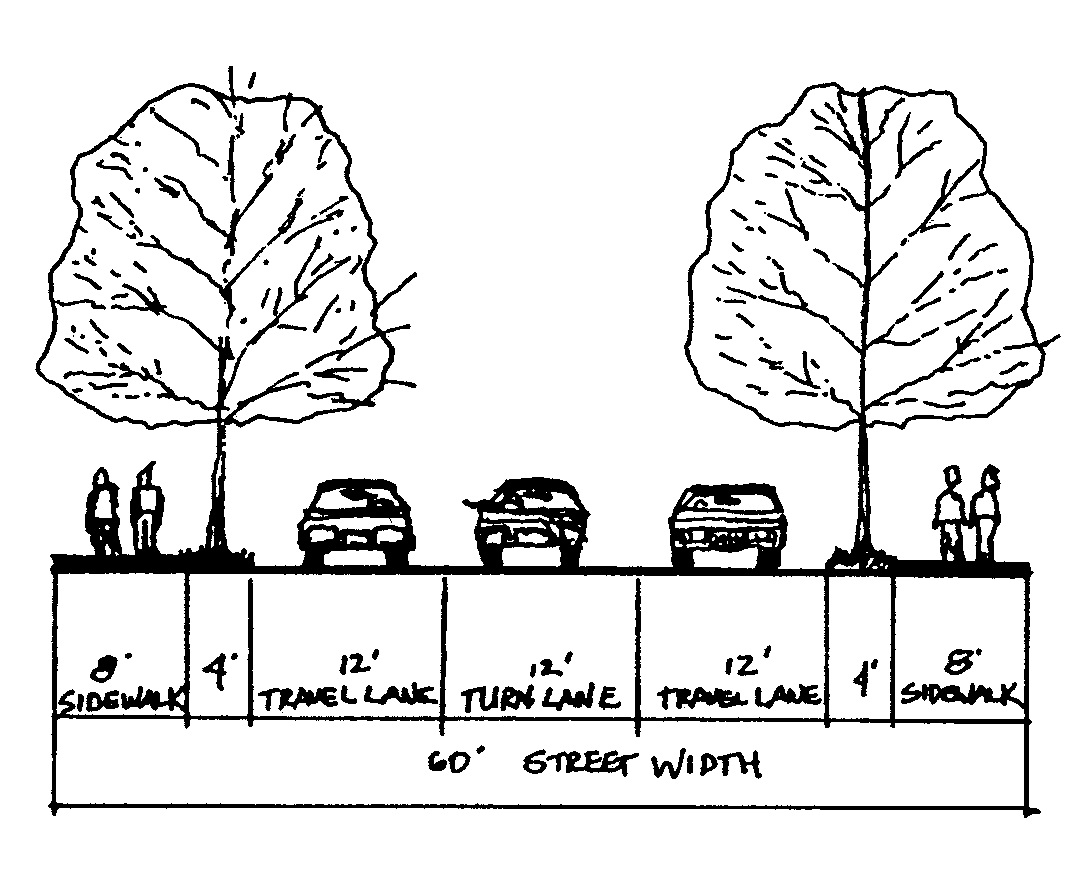
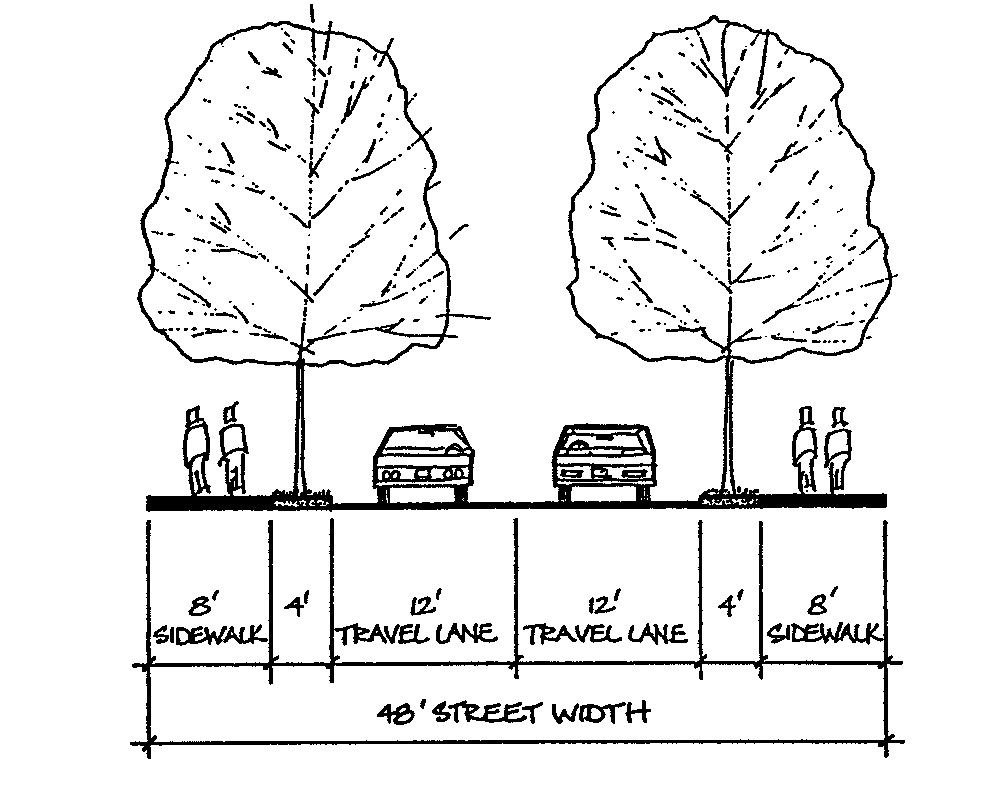
B. All streets shall be designed to create blocks which are no greater than four hundred (400) feet on a side. In cases where topographic or other environmental constraints preclude the creation of a four hundred (400) foot by four hundred (400) foot block size, the four hundred (400) foot maximum block length shall apply to only two (2) sides of a block, and the maximum block length may be waived by the Director.
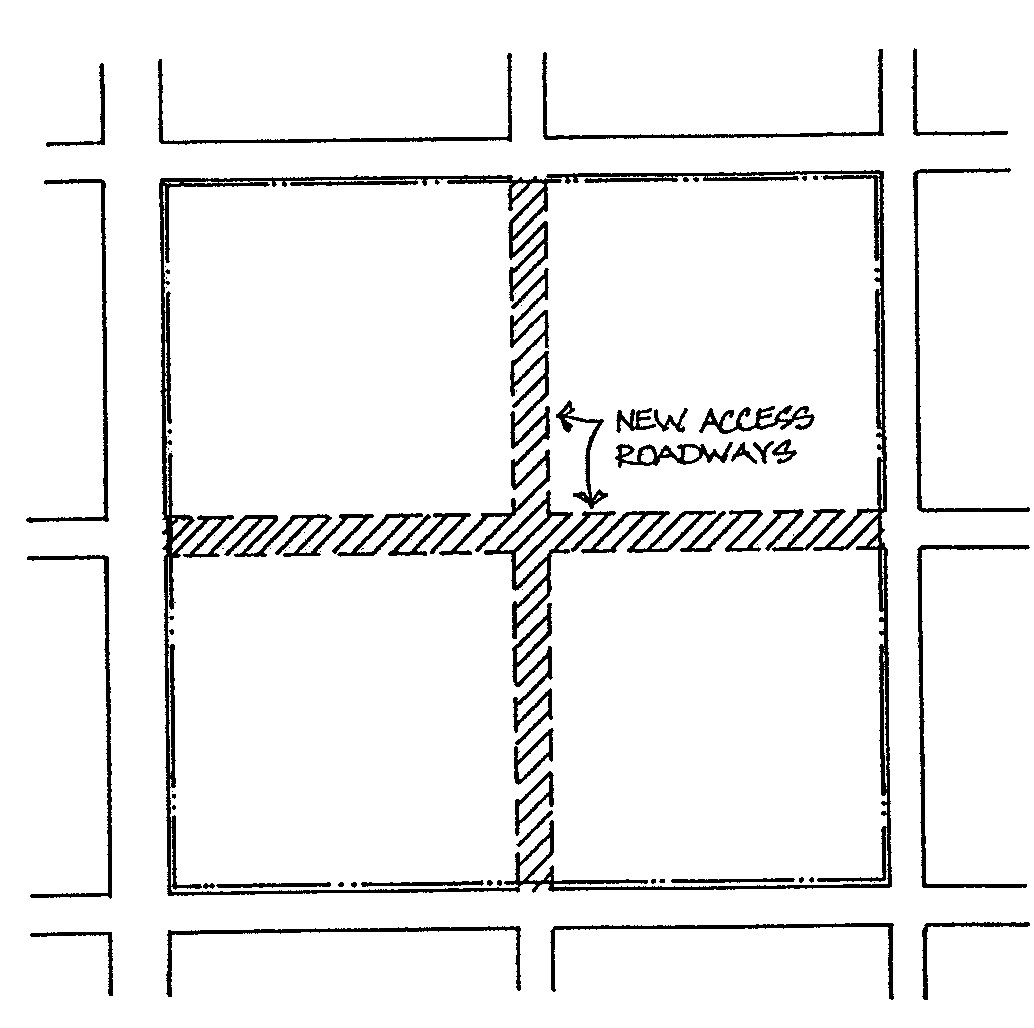
C. An owner or developer shall coordinate with owners of adjacent parcels and consolidate, wherever possible, vehicular circulation routes to interconnect public and/or private streets in conformance with the adopted City Center Plan. Where appropriate, circulation corridors shall extend to the boundary line of the site parcel in order to provide for future development of adjacent parcels and connections with existing public and/or private streets.
D. Dead-end streets shall be permitted only where there is no feasible connection with an adjacent public and/or private street.
E. Half-streets shall not be allowed, except as an interim circulation route as approved by both the Director and the Director of Public Works, in which the other half of the public or private street shall be developed on an adjacent parcel.
F. Public and private streets should not be enclosed. In cases where buildings are allowed to span public or private streets, the following standards shall apply:
1. The minimum ceiling height shall meet highway standards;
2. Lighting sufficient to provide a safe pedestrian environment shall be in operation at all times;
3. At the time of development, ground level retail space shall be constructed in accordance with the provisions of SMC 15.300.730, Ground Floor Uses in Mixed Use Projects, except as provided below:
a. Ground level retail space shall be constructed either on one (1) side of City Center Overlay District streets (collectors or minor arterials), for the full length of the enclosed area; or
b. Shall be constructed on both sides of the collector or minor arterial for fifty percent (50%) of the length of the enclosed area; and
c. Shall be served by the minimum utilities necessary for occupancy. These utilities include electricity, and sewer and water service;
4. Ground level retail space shall conform to the ground level transparency requirements specified in SMC 15.300.610(A), Ground Floor Transparency Requirements;
5. A minimum of one (1) piece of public art, approved by the Director, shall be included for every fifty (50) feet of enclosed length. Art work may include, but is not limited to, the following suggestions:
a. Artistic wall treatments such as painted murals, bas-relief murals, photographic montages, mosaics;
b. Artistic pavement or ceiling treatments as approved by the Director;
c. Neon lighting sculptures or other artistic lighting displays;
6. Ventilation systems to provide air inside the covered area that is at least as clean as ambient levels in the City Center Overlay District outside the enclosure shall be in operation at all times;
7. The interior space of the covered area shall appear in all aspects to be “pedestrian-oriented.” (Ord. 16-1022 § 1 (Exh. C); Ord. 15-1018 § 1)
15.300.120 Pedestrian Circulation Requirements
A. All site plans proposing multiple buildings designed for residential occupancy or business access shall connect building entrances to one another and to pedestrian ways on adjacent public and/or private streets via a minimum four (4) foot wide walkway system separated from vehicular traffic. Public sidewalks may be considered part of the walkway system if they provide convenient movement between structures. Fences, landscaping and other site improvements shall be located so as not to impede safe and convenient pedestrian circulation.
B. On-site pedestrian ways shall be designed to connect to off-site pedestrian way systems on adjoining properties and public and/or private streets. On-site extensions of pedestrian circulation systems shall align with existing pedestrian off-site links.
C. Pedestrian-only corridors separate from the vehicular street system, as specified by the adopted City Center Plan (see “Pedestrian Connections” in City Center Plan, Figure 5.1), shall be a minimum of twenty (20) feet wide with a minimum twelve (12) foot pathway of an approved surfacing material.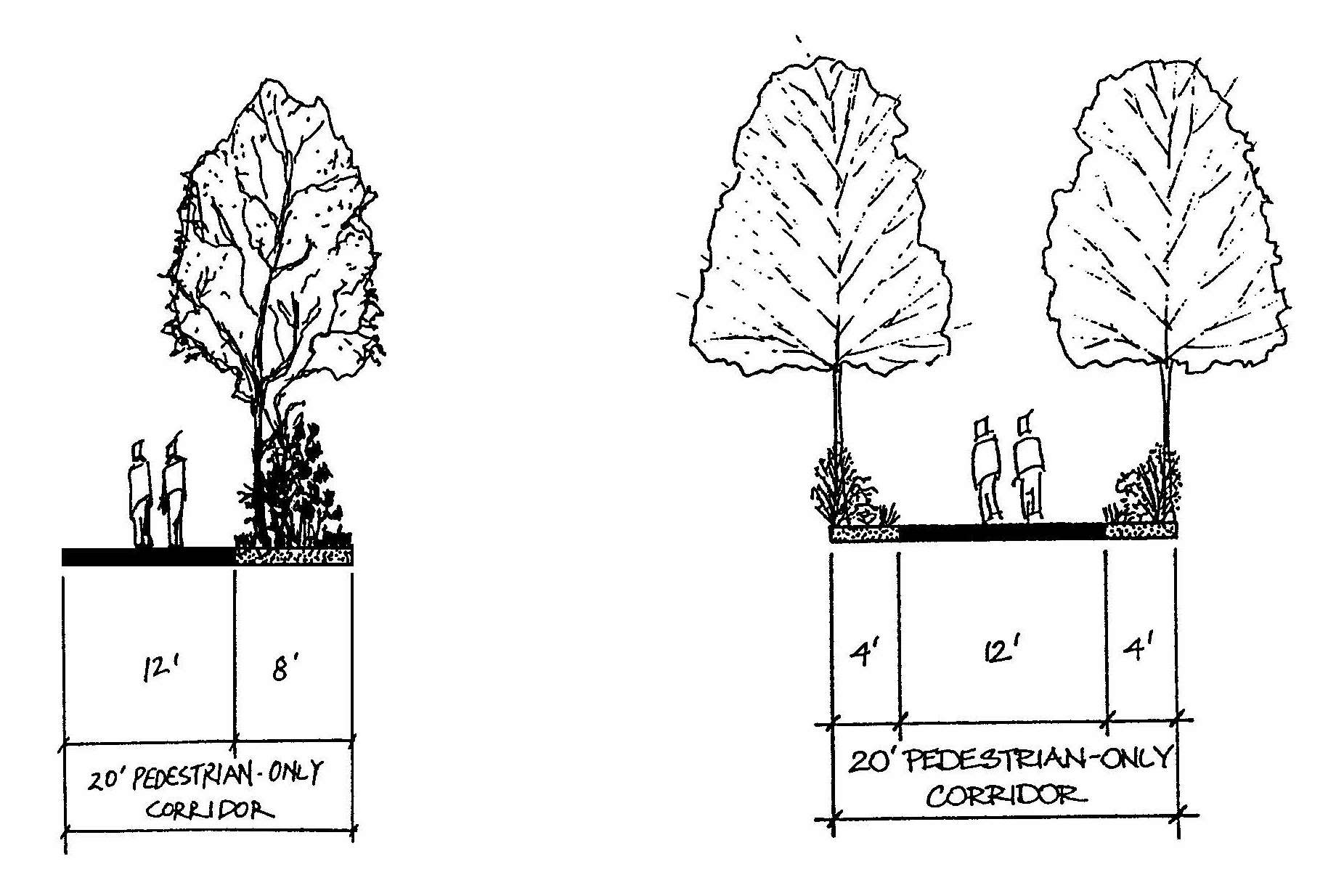
D. Buildings or structures approved by the Director to be built across a designated pedestrian-only corridor, as specified in the City Center Plan (see “Pedestrian Connections” in City Center Plan, Figure 5.1), shall provide public pedestrian access through said structures at least between the hours of 6:00 a.m. and 8:00 p.m. daily.
E. Public easements for pedestrian circulation shall be open to the public twenty-four (24) hours a day, except as specified in subsection (D) of this section. Private easements for pedestrian circulation should remain open to the maximum extent possible.
F. Primary pedestrian circulation and access shall be at grade. Elevated pedestrian walkways, if approved by the Director, may be permitted for the following purposes:
1. To provide an extension to or direct connection with an elevated walkway/moving sidewalk;
2. To overcome obstacles of terrain;
3. To connect immediately adjacent components of a single development; or
4. To connect with elevated transit stations.
G. To promote public transit use, paved sidewalks or walkways shall be provided between building entrances and the nearest transit stop located within or adjacent to the subject property. Wherever possible, buildings shall be sited adjacent to or connected with transit stop facilities. Lighting shall be provided along pedestrian walkway connections and adjacent to transit stop facilities. 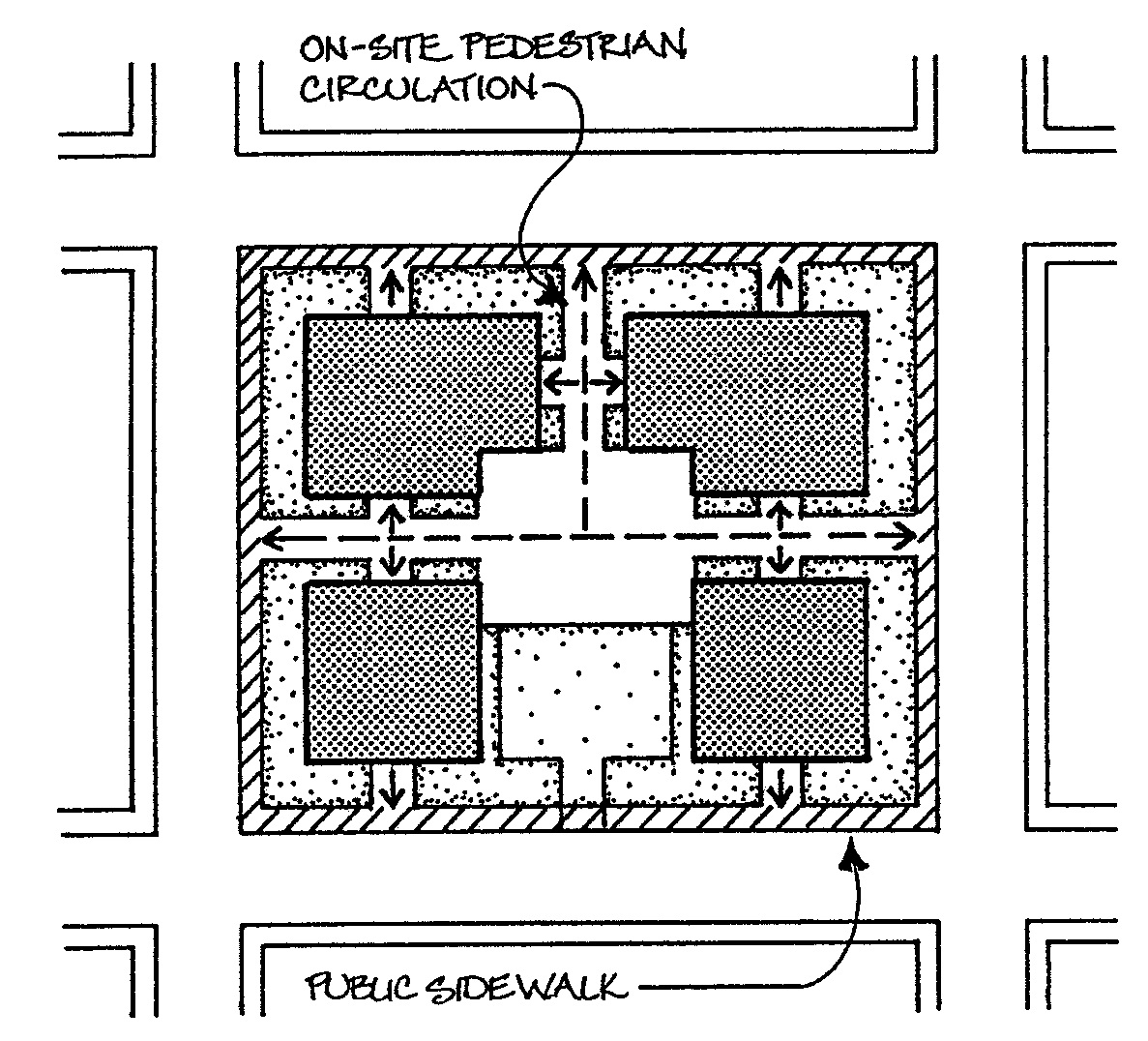
(Ord. 15-1018 § 1)
15.300.200 Site Planning and Building Orientation
Purpose: Design structures to have both an external orientation, to the streetscape, and an internal orientation, to the pedestrian environment with unifying open space and pedestrian pathways. Design emphasis should be given to the pedestrian, rather than the auto environment, through placement of parking in a less prominent location (such as underground, or to the rear of the building, rather than in front), the requirement of pedestrian-level retail space; treatment of blank walls and facades and incorporation of prominent architectural features. Site layout should emphasize coordination of open spaces and pedestrian access with adjacent development or public places and compatibility with adjacent development with regard to scale, proximity and landscaping. Lighting and landscaping should allow for safety and visibility of public and semi-public areas. (Ord. 15-1018 § 1)
15.300.210 Building Placement/Setbacks
A. Maximum Front Yard Setback. For City Center Overlay District properties zoned UH-UCR, CB-C, and O/CM, the maximum front yard setbacks shall be as follows, except as provided under SMC 15.300.460(B), Parking Structure Placement and/or Setbacks:
1. Twenty (20) feet adjacent to International Boulevard, for at least fifty percent (50%) of the building’s front facade;
2. Ten (10) feet adjacent to all other City Center Overlay District public and/or private streets, as specified in the City Center Plan (see City Center Plan, Figures 5.1 – 5.1b), for at least fifty percent (50%) of the building’s front facade.
B. Building Orientation. The front facade of the primary building(s) on site shall be oriented toward the front property line, with the main pedestrian entrance(s) located on this front facade. Additional building entrances may be oriented toward the rear or side of the building for access to and from parking lots.
C. Minimum Building Frontage. At least fifty percent (50%) of the building’s front facade shall be located within the maximum front yard setback, as specified in subsections (A)(1) and (2) of this section. The remaining portions of the front facade may be stepped back a maximum of twenty (20) feet more than the established maximum setback, as approved by the Director, for the purpose of accommodating public open space, porte-cocheres, or recessed building entries.
D. Building Placement/Setbacks and Open Space. Building placement and setback shall be arranged to accommodate the front yard open space requirement as specified in SMC 15.300.320, Front Yard Open Space.
E. Setbacks and Landscaping Standards for CB-C Zone. For projects in the CB-C zone, where the side and rear setbacks in the dimensional standards chart in SMC 15.400.100 conflict with the required landscaping in Chapter 15.445 SMC, Landscaping and Tree Retention, the side and rear yard setbacks in the landscaping standards in SMC 15.400.100 shall supersede. This shall not apply where side and rear property lines abut a residential zone.
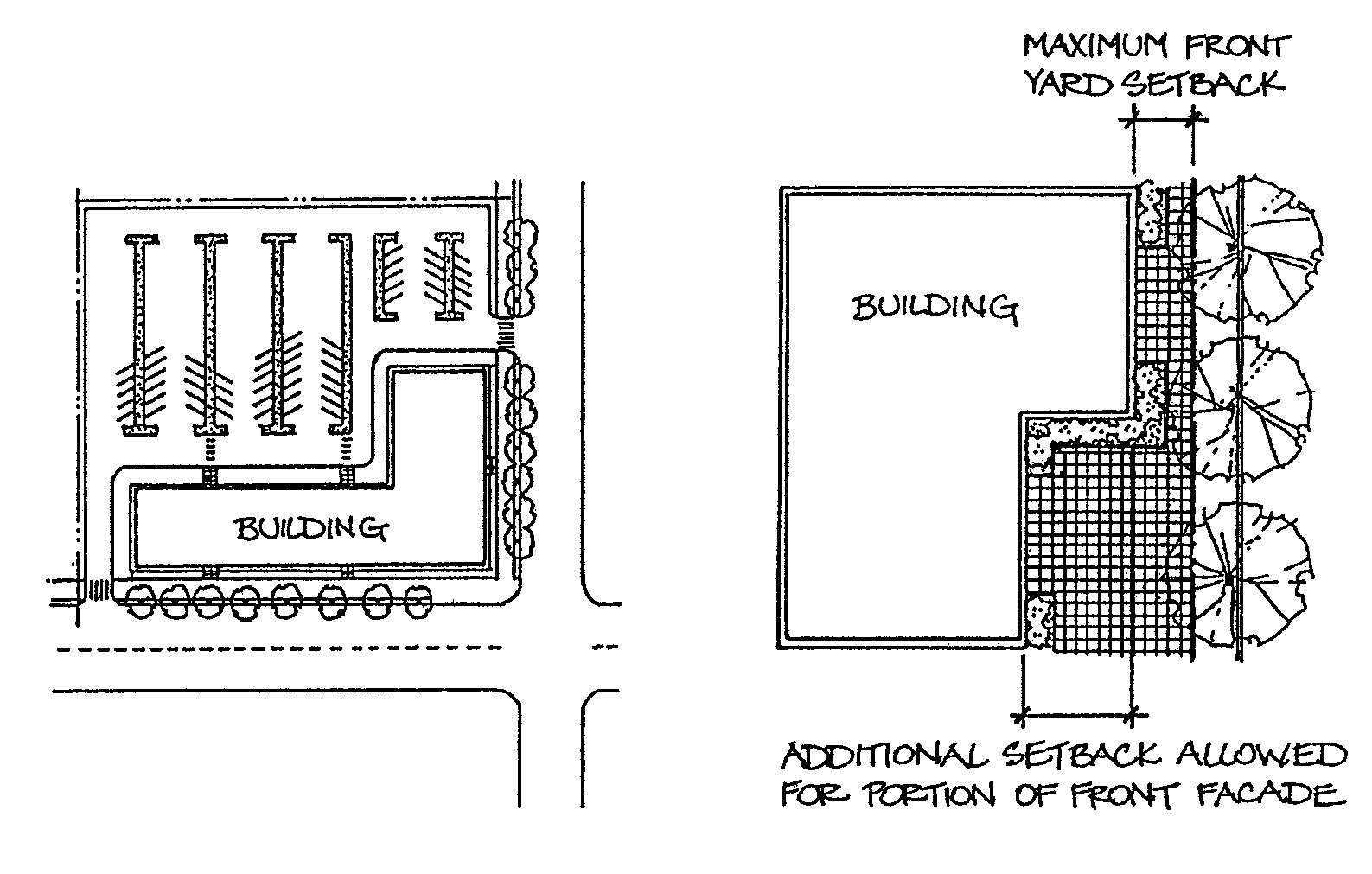
(Ord. 15-1018 § 1)
15.300.220 Development Abutting Two (2) or More Street Frontages
A. Buildings on corner lots shall orient front facades to both the corner and adjacent public and/or private street fronts. Pedestrian entries near or on the corner are encouraged.
1. Corner Buildings and Architectural Focal Points. Development at the intersection of a principal arterial with either a principal or minor arterial shall include architectural focal points that increase the visibility and landmark status of corner buildings, such as one (1) or more of the following:
a. Transparent glazing incorporated into corner building design;
b. Tower elements and/or rooflines that accentuate the corner;
c. Balconies or building terraces at or near the corner.
B. If the subject property abuts public and/or private streets classified as principal arterials by the SeaTac Comprehensive Plan along both its front and rear property lines, then the property owner shall either:
1. Design a single building with facade entries oriented toward both the front and rear property lines; or
2. Orient one (1) or more buildings toward the front property line along with a designated location for a current or future building or buildings oriented toward the rear property line.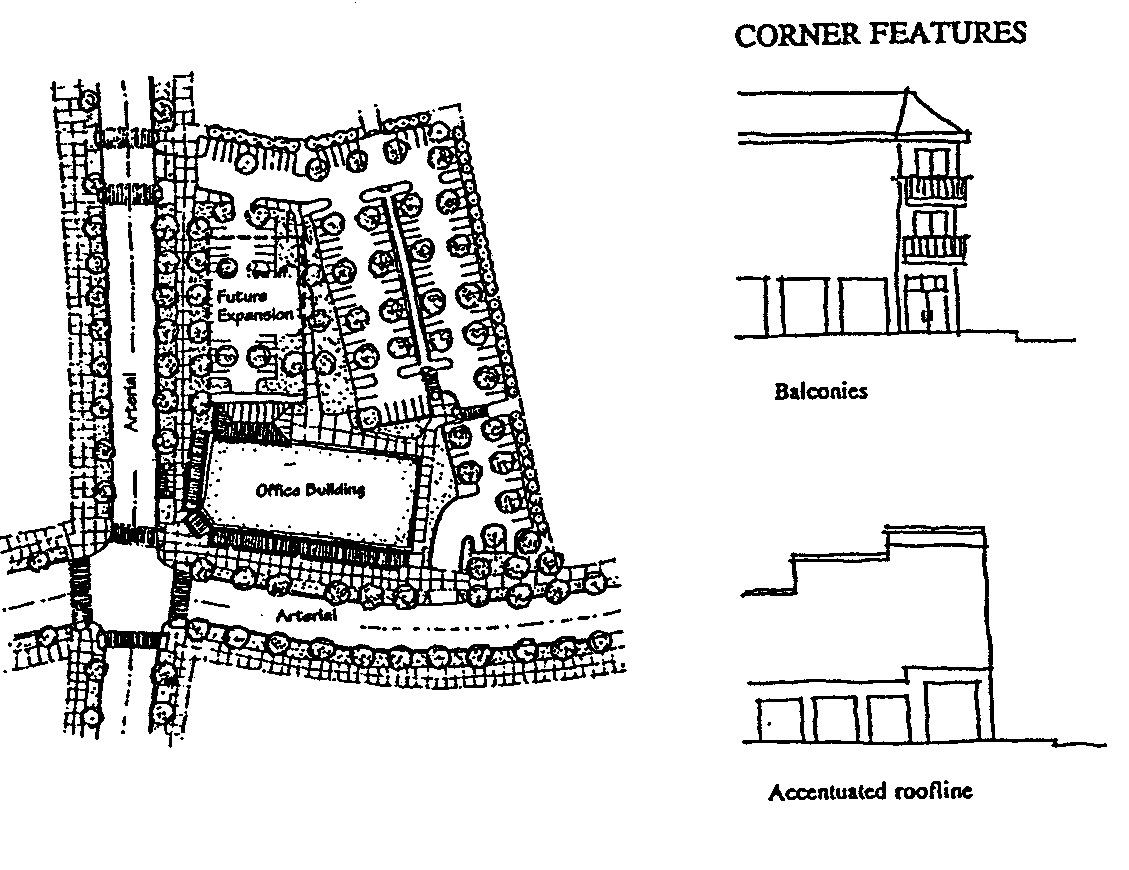
(Ord. 15-1018 § 1)
15.300.230 Relation to Adjacent Development
Proposed developments shall coordinate with current site planning and development efforts on adjoining parcels to take advantage of opportunities to mutually improve development design.
A. Adjacent developments shall link open spaces and landscaping whenever possible.
B. Proposed developments shall provide publicly accessible pedestrian connections to adjacent residential neighborhoods wherever possible, via a through-block walkway or links to sidewalks. Provide stairs or ramps where necessary when topographic barriers, such as steep slopes, inhibit direct access to surrounding development or destination points, such as transit stops.
C. Where multi-family residential development is located adjacent to retail, commercial, employment, or institutional uses, side and/or rear yard landscape buffers shall be intersected by approved pedestrian circulation routes in order to facilitate convenient walking connections to adjacent uses or services.
D. Buildings or structures that terminate view corridors shall include architectural features that increase the visibility and landmark status of the subject building facade, such as a clearly defined building modulation, pedestrian entry feature, and/or roofline that accentuates the building as a focal point.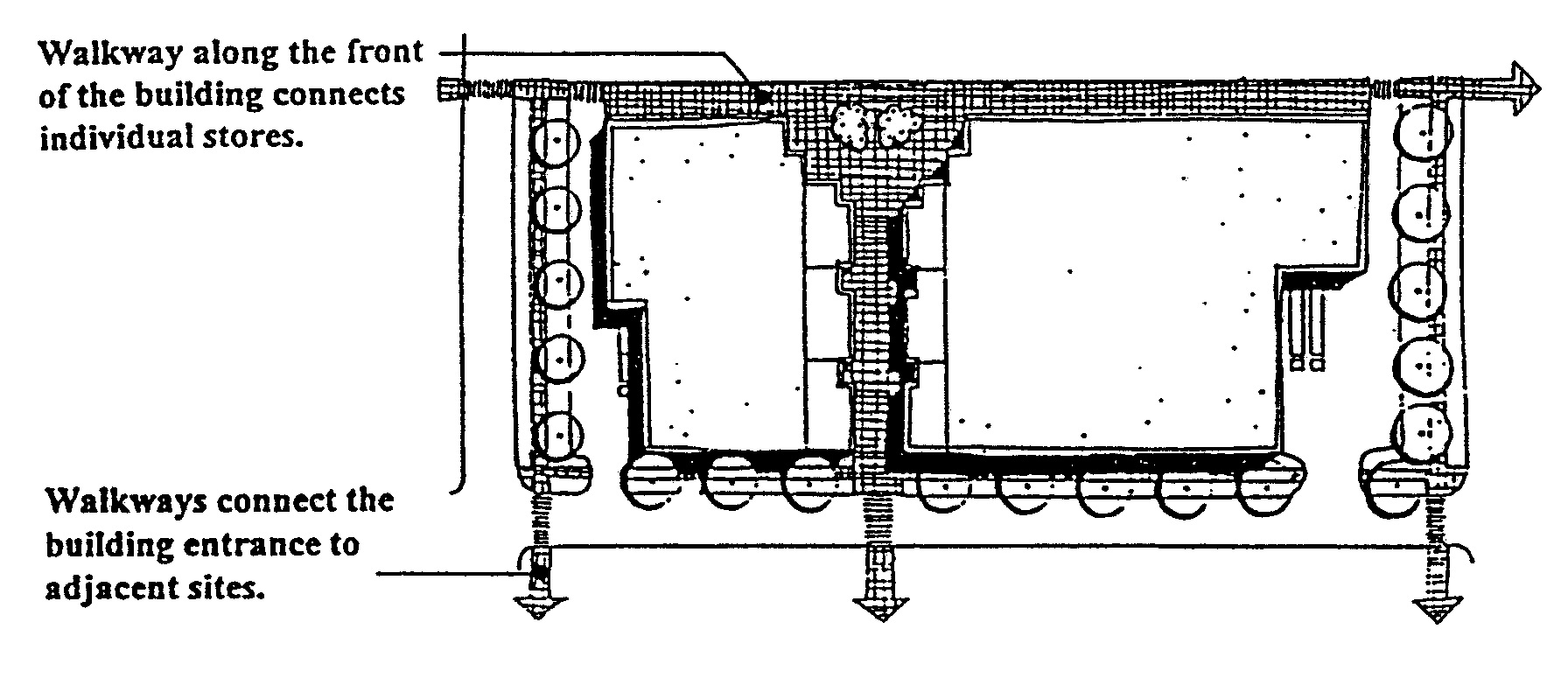
(Ord. 15-1018 § 1)
15.300.240 Projects on or Near the Edge of a UL or UM Residential Zone
Careful siting and design treatment is necessary to achieve a compatible transition between two (2) zones of differing height, bulk and scale requirements. In order to mitigate potential impacts of CB-C and UH zone development on neighboring residential districts, the following standards shall apply:
A. Adjacent to UL Zone. Properties abutting a UL zone shall incorporate the following:
1. A maximum building height of thirty-five (35) feet, relative to the base elevation of the adjacent UL zoned parcel(s) where that base elevation is higher than the base elevation of the proposed project, shall apply to all portions of a structure within sixty (60) feet of a UL zone, including access roadway widths; provided, that the overall height of any structure shall not exceed the maximum structure height specified in the dimensional standards charts in SMC 15.400.100; and
2. A minimum side and/or rear yard building setback of twenty (20) feet shall apply if the side or rear property boundaries are adjacent to a UL zone. Side/rear yard landscaping shall occupy all or part of the required building setback, as specified in the landscaping chart in SMC 15.445.210.
3. Parking shall not be permitted within the side and/or rear yard building setback adjacent to a UL zone.
B. Adjacent to UM Zone. Properties abutting a UM zone shall maintain a minimum side and/or rear yard building setback of twenty (20) feet, if the side or rear yard property boundaries are adjacent to a UM zone. Side/rear yard landscaping shall occupy all or part of the required building setback, as specified in the landscaping chart in SMC 15.445.210.
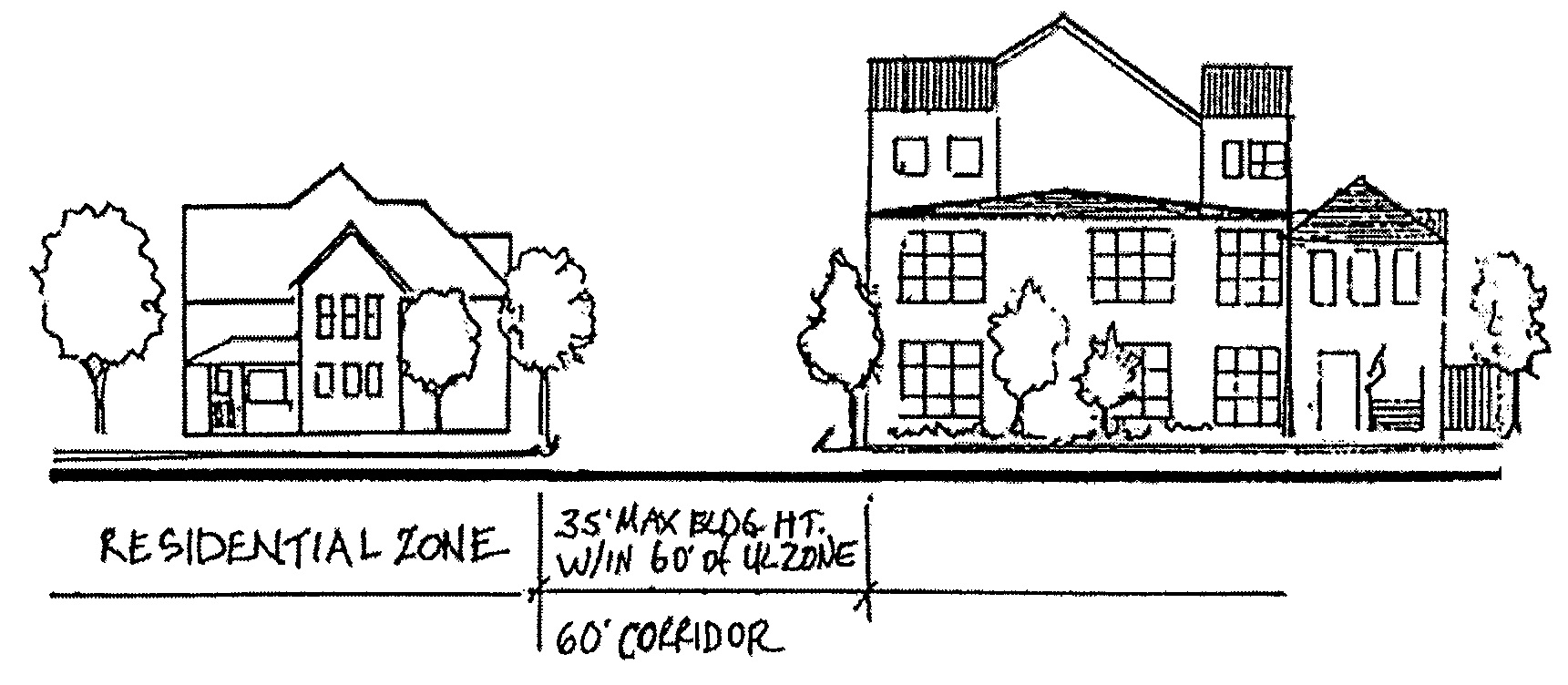
(Ord. 15-1018 § 1)
15.300.250 The Layout and Width of Streetfront Pedestrian Zone
Within the City Center Overlay District, all new sidewalks and street improvements shall include a streetfront pedestrian zone, consisting of street landscaping and a sidewalk clear-through zone.
A. Sidewalk Clear-Through Zone. A pedestrian sidewalk clear-through zone shall be created along the public and/or private street frontage consisting of a minimum eight (8) foot wide paving area free of physical obstructions to pedestrian movement.
1. The combination of street landscaping and sidewalk clear-through zones shall form a minimum twelve (12) foot wide pedestrian zone between the street curb and any building edge or facade landscaping bed.
B. Street Landscaping Zone. A minimum four (4) foot wide street landscaping zone shall be required adjacent to the street curb, consisting of a combination of trees, landscaping, light poles, and street furniture in a manner to be approved by the Director.
1. The street landscaping zone will include either tree wells and grates for street trees; or shrubs, ground cover and/or lawn in addition to street trees.
2. Street trees shall be deciduous shade trees capable of at least twenty-five (25) feet in height. Street trees shall be planted within the street landscaping zone along public and/or private streets and be spaced no more than thirty (30) feet apart as described in street landscaping standards in Chapter 15.445 SMC, Landscaping and Tree Retention, except where variations in tree spacing, as approved by the Director, may be considered to enhance plaza areas, emphasize building focal points or avoid visually blocking retail storefront entrances.
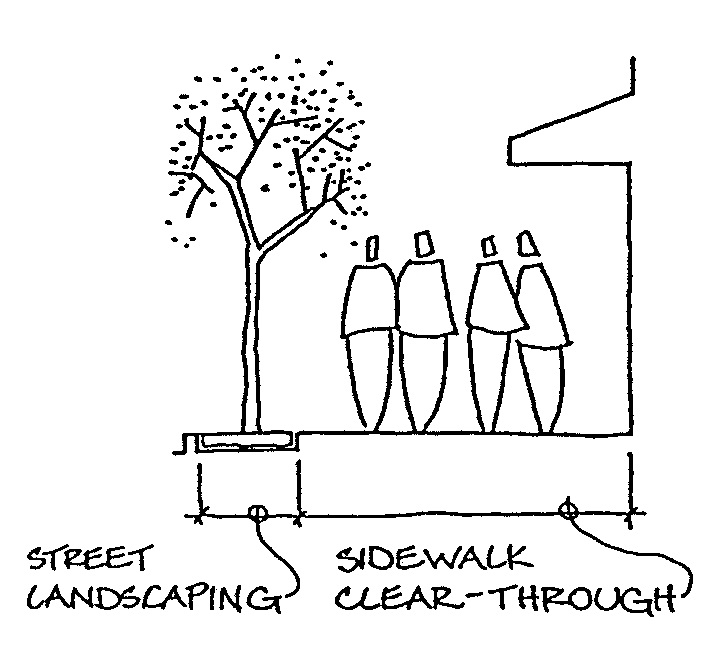
(Ord. 15-1018 § 1)
15.300.260 Driveway Entrances
A. Automobile access shall be consolidated with no more than one (1) driveway per one hundred fifty (150) linear feet of street frontage.
B. Pedestrian entry routes interrupted by driveways shall be distinguished from the driveway surface by decorative paving to the building entrance.
C. Driveways serving front yard porte-cochere building entries shall be approved by the Director and include only the short-term parking that can be accommodated along one (1) double-loaded drive aisle.
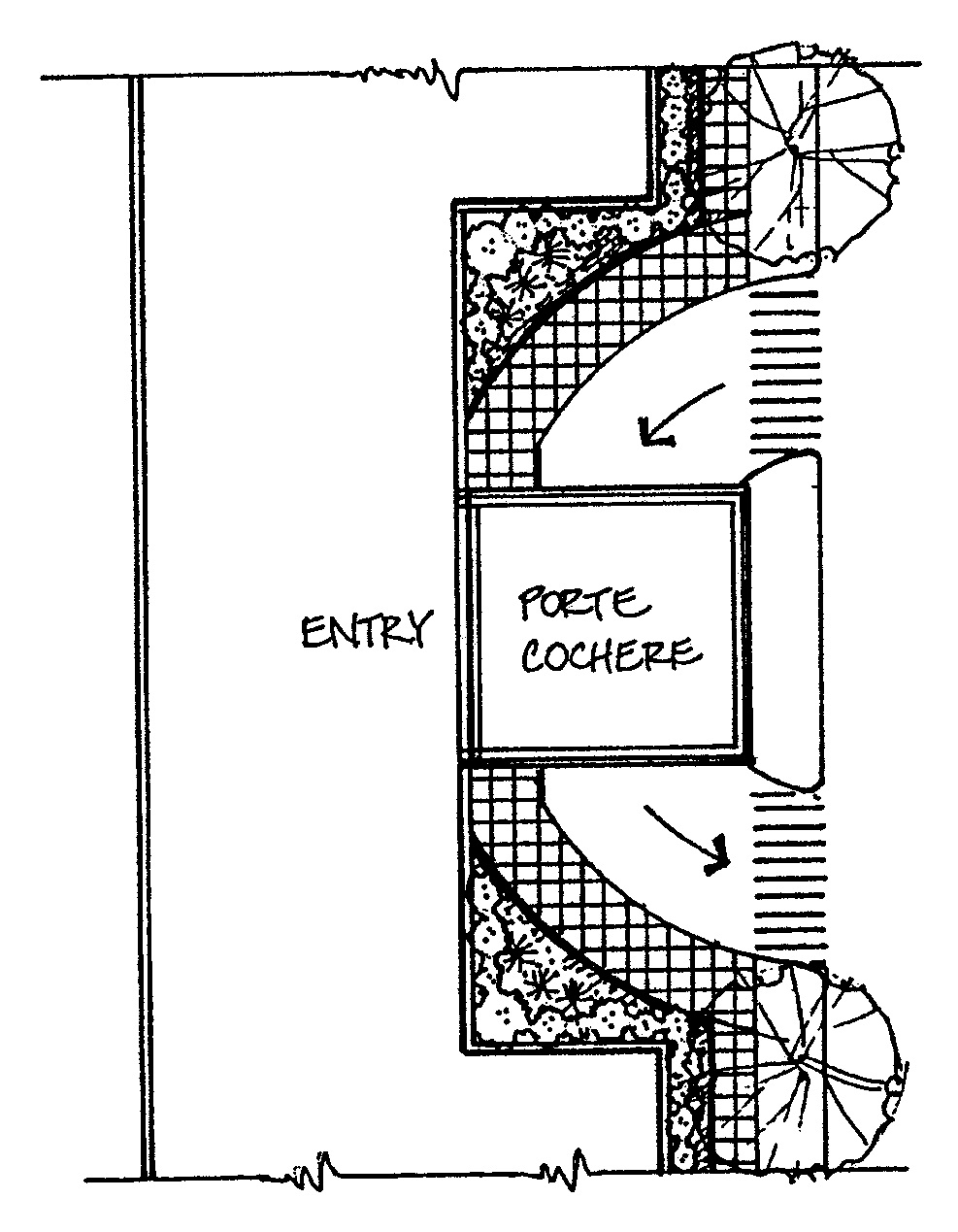
(Ord. 15-1018 § 1)
15.300.270 Location of Drive-Through Stacking Lanes
Driveway stacking lanes associated with drive-through facilities shall not be located between the building and any property line adjacent to a public and/or private street. (Ord. 15-1018 § 1)
15.300.280 Exterior Lighting
A. Lighting standards shall be no greater than sixteen (16) feet in height, and used to illuminate surfaces intended for pedestrians or vehicles, as well as building entries. Light fixtures shall be sited and directed to minimize glare around residences.
B. Exterior lighting shall be used to identify and distinguish the pedestrian walkway network from car or transit circulation. Along pedestrian circulation corridors, lighting standards shall be placed between pedestrian ways and public and/or private streets, driveways or parking areas. The level of lighting shall conform with the requirements of Chapter 17.40 SMC, Walkway, Bikeway and Park Lighting.
C. Light standard designs shall be approved by the Director, and be in conformance with a consistent lighting standard design throughout the City Center Overlay District. 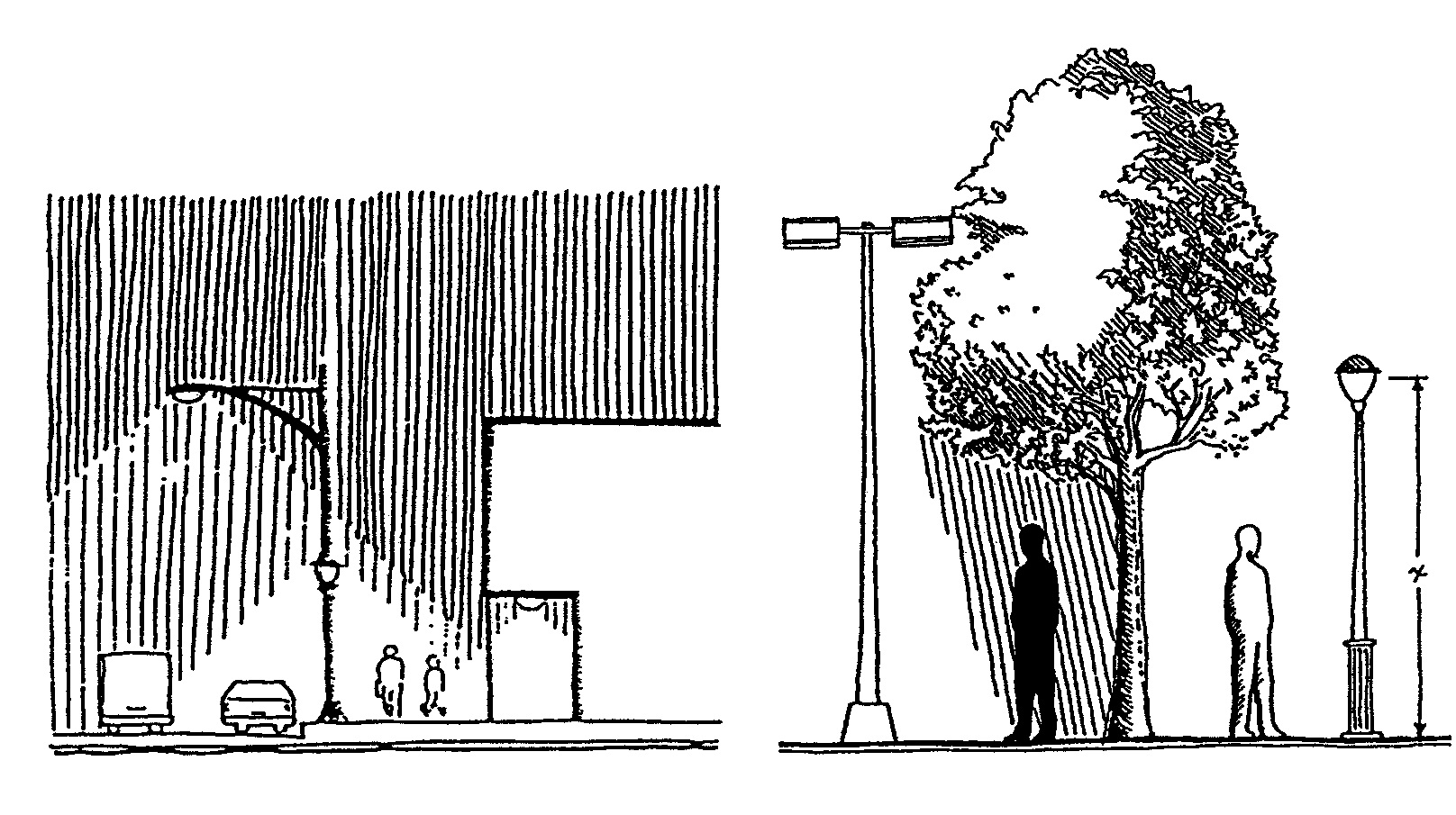
(Ord. 15-1018 § 1)
15.300.300 Open Space and Amenities
Purpose: Break up dense development patterns with passive or active open spaces such as plazas, parks, trails and other means and link them wherever possible. Open spaces should be usable, have good access and take advantage of local amenities such as Bow Lake. (Ord. 15-1018 § 1)
15.300.310 Minimum Open Space Area Required
A. A minimum of ten percent (10%) of net site area shall be set aside as usable outdoor open space accessible to the public.
1. Areas That Do Not Qualify as Open Space. The following shall not be included toward meeting the minimum open space requirement:
a. Portions of a parcel classified as wetland; storm water facility; provided, that such storm water facilities are at grade and not covered; or open water.
b. Required landscaping and sensitive area buffers without common access links, such as pedestrian trails.
c. Driveways, parking, or other auto uses.
d. Areas of a parcel with slopes greater than eight percent (8%) shall not qualify as usable outdoor open space, unless the area has been developed with an enhanced accessibility system of stairs, ramps, terraces, trails, seating areas, or other site improvements as approved by the Director.
e. Parcels adjacent to Bow Lake may not count areas of open water for the purpose of calculating the open space area requirement.
f. Wetland buffer and setback areas shall also be excluded for the purpose of calculating the open space requirement.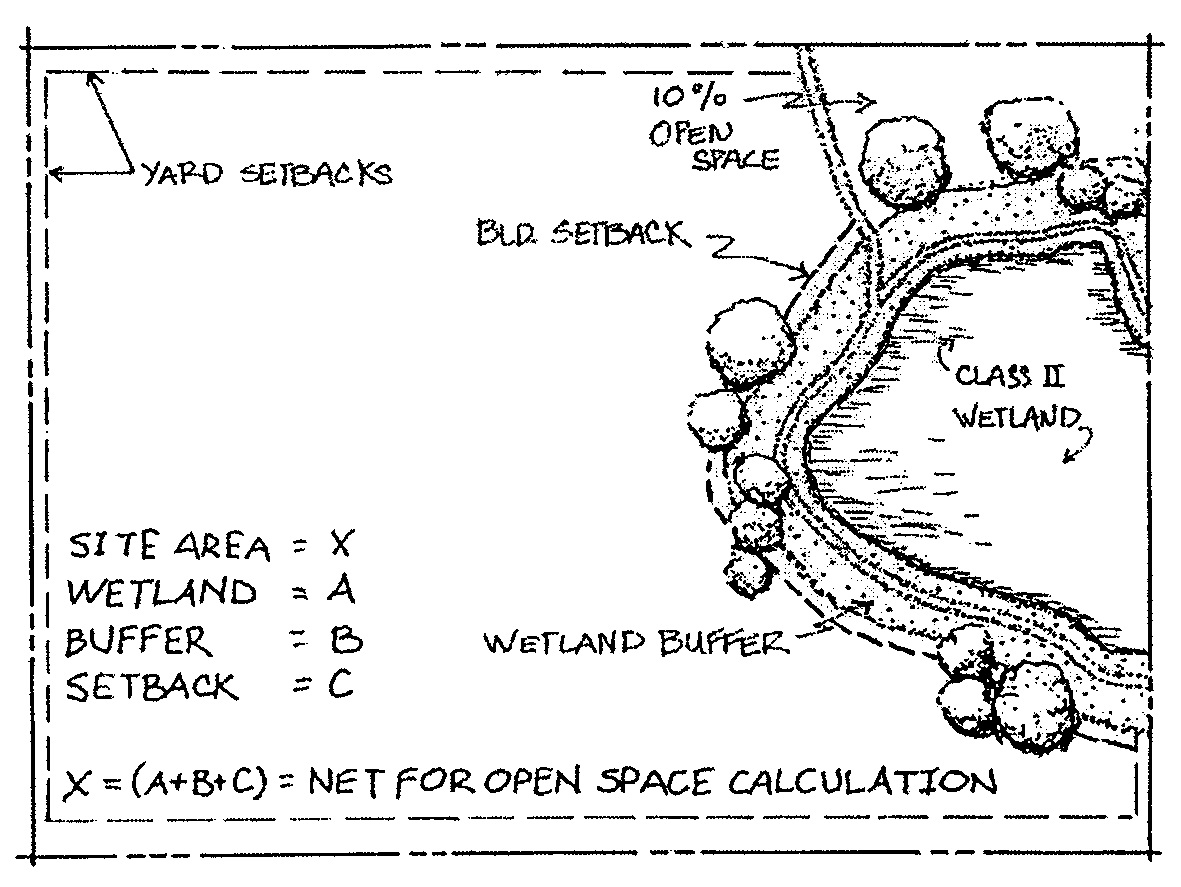
B. Areas That Qualify as Open Space. Usable open space that qualifies toward meeting the minimum open space requirement shall include one (1) or more of the following:
1. Active outdoor recreation areas;
2. Multi-purpose green spaces;
3. Publicly accessible pathways that are part of a vegetated roof design;
4. Permeable pavement trails;
5. Pedestrian-only corridors separate from the public or private roadway system and dedicated to passive recreation, including access links in sensitive area buffers. The square footage (length times width) of pedestrian-only corridors shall be counted as usable open space; and/or
6. Publicly accessible plazas, courtyards, pocket parks and decorative or permeable paving areas constructed contiguous with a new or existing sidewalk located either within the front yard setback or elsewhere on site. Publicly accessible courtyard designs shall conform to the following standards:
a. The courtyard dimension is a measurement of the usable open space between two (2) buildings or to a property line, and shall have a width equal to the height of the building, up to a maximum of seventy-five (75) feet, but in no case less than twenty (20) feet.
b. If the enclosing walls of a courtyard terrace upward and back with succeeding stories, the courtyard dimension shall be measured from the lowest enclosing floor or projection.
C. Front Yard and Lakefront Open Space and Minimum Requirement. The front yard open space requirement as per SMC 15.300.320, and lakefront open space requirement as per SMC 15.300.325 may be counted toward the minimum open space area requirement. (Ord. 16-1022 § 1 (Exh. C); Ord. 15-1018 § 1)
15.300.320 Front Yard Open Space
The following front yard open space regulation shall supersede the street frontage landscape requirement as specified in SMC 15.445.010(C) and 15.445.210. The building facade landscaping requirement shall continue to apply to uses in the City Center, except under pedestrian weather protection structures, as specified in SMC 15.300.610(B).
A. Front Yard Open Space Requirements. Front yard open space area equal to the square footage of a five (5) foot strip along the length of the street-facing front facade(s) shall be developed and arranged as described in SMC 15.300.340(B), Arrangement and Design of Front Yard Open Space. (Ord. 15-1018 § 1)
15.300.325 Incorporating Bow Lake as a Focal Point
New development and major redevelopment adjacent to Bow Lake shall be designed to increase opportunities for the public to both view and access the lakefront area, while at the same time minimizing impacts on the waterway’s biologic and hydrologic functions.
A. The Bow Lake waterfront buffer and building setback area, as required in Chapter 15.700 SMC, Environmentally Sensitive Areas, SMC 15.700.180, Building Setbacks, should be made publicly accessible through the construction of pedestrian access trail links, seating areas, and shoreline viewing points, in conformance with SMC 15.700.290, Wetlands – Permitted Alterations.
B. Adjacent lakefront developments shall link waterfront open spaces and associated pedestrian circulation systems.
C. Properties adjacent to Bow Lake shall provide a pedestrian access corridor to the lakefront area from an adjacent public or private street. Side yard pedestrian access links may be shared between adjacent properties.
1. All nonresidential properties abutting Bow Lake and associated wetlands shall provide at least one (1) clearly marked public entry facing the lake designed to connect with the planned pedestrian trail.
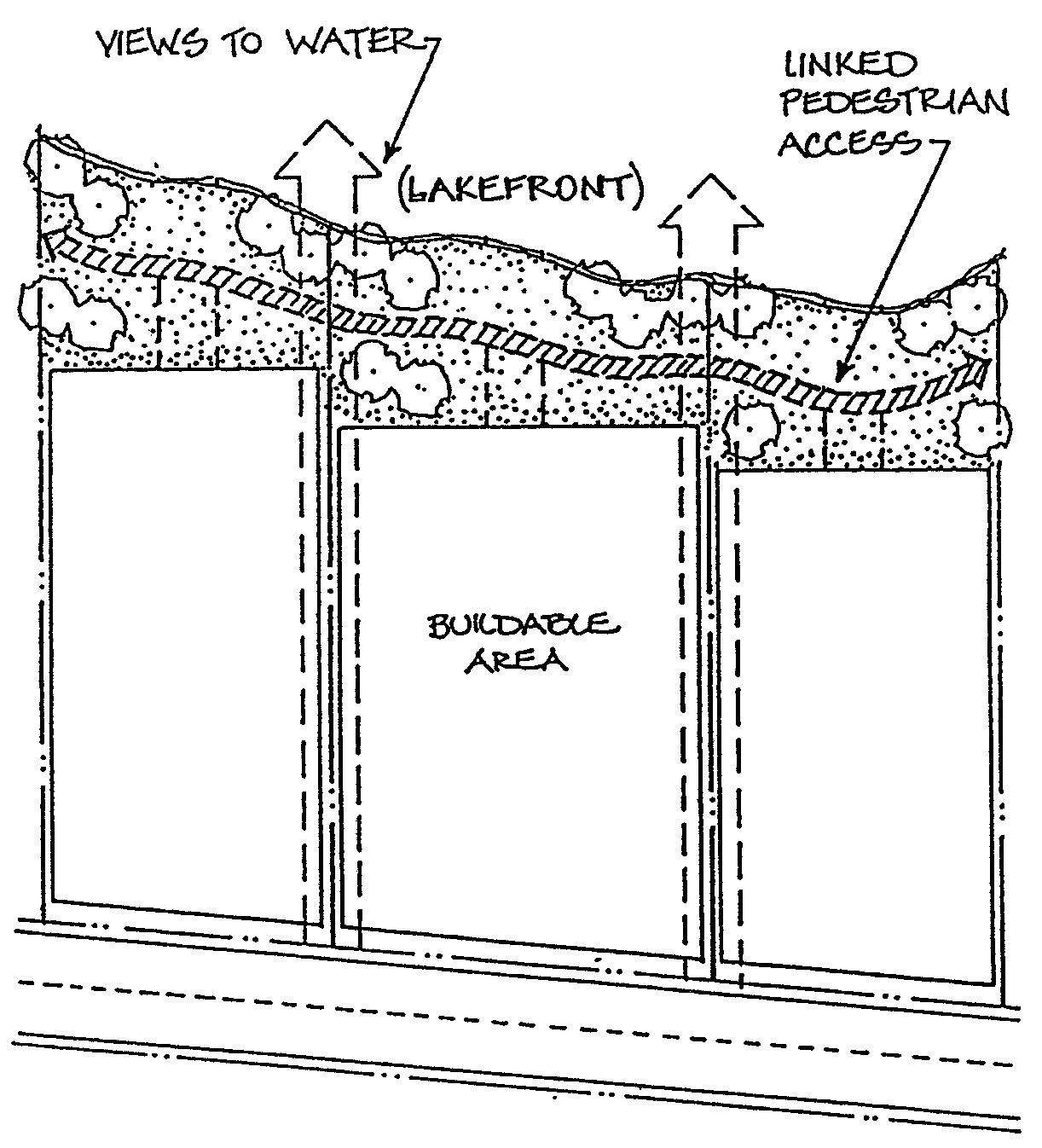
(Ord. 15-1018 § 1)
15.300.330 Alternative Methods for Meeting Open Space Requirement
Developments have the option of contributing to a City Center open space fund in lieu of setting aside additional on-site open space area greater than the minimum required in both the front yard, as per SMC 15.300.320, Front Yard Open Space, and along lakefronts, as per SMC 15.300.325, Incorporating Bow Lake as a Focal Point.
A. The City shall use the funds contributed to the City Center open space fund within six (6) years on an approved open space/park project or return said funds to contributors.
B. Revenue from the City Center open space fund may be applied only to open space/park projects within the defined City Center area.
C. To receive exemption for an amount of on-site open space totaling less than the required open space area, a contribution to the City Center open space fund shall be made in an amount that equals the monetary value of that portion of site area which is less than the required open space. (Ord. 15-1018 § 1)
15.300.340 Open Space Design Standards
A. General Open Space Design Requirements.
1. Integration with Adjacent Parcels. Usable open space areas on site shall be organized and designed in a manner that allows for maximum integration with open space on adjacent parcels, as specified in SMC 15.300.230.
2. Linkage of Open Space Elements. Developments proposing on site plazas and pocket parks as publicly accessible project amenities shall link the open space elements with adjacent sidewalks, pedestrian paths, and/or bikeways.
B. Arrangement and Design of Front Yard Open Space. Front yard open space shall be developed and arranged in a manner that is accessible to the public at all times, directly connected to a sidewalk or pedestrian pathway, and bordered on at least one (1) side by, or readily accessible from, approved structure(s) on site. Front yard open space shall be placed in one (1) or more of the following ways, as approved by the Director:
1. Plaza, Courtyard, or Pocket Park. Publicly accessible open space of a minimum two hundred (200) square feet that is adjacent to a pedestrian building entrance and consisting of at least fifty percent (50%) decorative paving. The remaining percentage of required open space area may be installed as plantings within or immediately adjacent to the plaza, courtyard, or pocket park. One (1) tree shall be required for every two hundred (200) square feet of decorative paving area. Decorative paving areas shall be constructed of such materials as stamped, broom finish, or scored concrete; brick or modular pavers;
2. Multi-Purpose Green Space. A combination of grass, pedestrian ways, and seating areas of a minimum two hundred (200) square feet. One (1) tree shall be required for every two hundred (200) square feet of green space area; and/or
3. Decorative Paving Contiguous with Sidewalk. A minimum five (5) foot wide decorative paving area constructed contiguous with a new or existing sidewalk along the length of the front yard building facade, coupled with a direct connection between the building entrance and sidewalk.
C. Performance Standards for Open Space.
1. Outdoor Seating. Publicly accessible plazas, courtyards, and pocket parks shall include at least one (1) linear foot of seating per each forty (40) square feet of plaza, courtyard, or pocket park space on site. Outdoor seating shall be in the form of:
a. Freestanding outdoor benches of a minimum sixteen (16) inches wide; or
b. Seating incorporated into low walls, raised planters or building foundations at least twelve (12) inches wide and eighteen (18) inches high.
2. Focal Point for Plazas, Courtyards and Pocket Parks. In addition to seating, publicly accessible plazas, courtyards, and pocket parks should incorporate one (1) or more of the following open space amenities in order to encourage pedestrian use and activity:
a. Public art, such as a water feature or sculpture;
b. Transit stops;
c. Performance/stage areas; or
d. Other public amenities, as approved by the Director.
3. Accessory Site Furnishing. Accessory site furnishings shall be located so as not to obstruct pedestrian access along sidewalks and to businesses.
a. Waste receptacles, movable planters and other accessory site furnishings shall be of a design which is compatible with the design of the plaza, courtyard, or pocket park, through the use of similar detailing or materials.
|
|
|
|
|
(Ord. 15-1018 § 1)
15.300.400 Parking Standards
A. Purpose. Minimize parking as a dominant land use. Parking should be screened through its placement behind structures and via landscaping.
B. The following parking standards shall be in addition to, or, in some cases, supersede applicable parking provisions required in Chapter 15.455 SMC, Parking and Circulation. (Ord. 15-1018 § 1)
15.300.410 Off-Street Parking Requirements and Reductions
A. Required Off-Street Parking Spaces.
1. Minimum Parking Requirements. The minimum parking spaces required shall be those established in the parking chart in Chapter 15.455 SMC, Parking and Circulation.
a. In cases where the minimum parking standards established in SMC 15.455.120 are greater than the maximum spaces allowed in subsection (A)(2) of this section, then the parking standards within this chapter as specified in subsection (A)(2) of this section shall supersede and also serve as the minimum number of parking spaces required.
2. Maximum Parking Requirements.
|
LAND USE |
MAXIMUM SPACES ALLOWED |
NOTES |
|---|---|---|
|
Where calculations result in fractions of parking spaces, the maximum number of parking stalls shall be determined by rounding up to the next whole number. |
||
|
Residential Uses |
||
|
College Dormitory |
1 per bedroom unit |
--- |
|
Duplex/Townhouse |
2 per dwelling unit |
--- |
|
Multi-Family |
1 per bedroom, up to 2 per dwelling unit maximum |
Unless modified by a parking plan demonstrating an increased need to serve residents. |
|
Community Residential Facility |
1 per bed |
|
|
Convalescent Center/Nursing Home |
1 per 3 beds |
|
|
Retirement Apartments |
1 per unit |
|
|
Recreational/Cultural Uses |
||
|
Conference/Convention Center |
5 per 1,000 SF of building area |
--- |
|
Library/Museum/Cultural Facility |
4 per 1,000 SF of building area |
--- |
|
Community Center/Recreation Center |
4 per 1,000 SF of building area |
--- |
|
Sports/Fitness/Health Club |
4 per 1,000 SF of building area |
--- |
|
Theater |
0.75 per fixed seat, plus 1 per employee |
--- |
|
General, Educational and Health Services Uses |
||
|
General Service Uses |
4 per 1,000 SF of building area |
--- |
|
Educational Uses |
1 per employee, plus 1 per 2 students |
--- |
|
Health Services Uses |
4 per 1,000 SF of building area |
--- |
|
Transitional Housing |
1 per 2 bedrooms |
Unless modified by a parking plan demonstrating an increased need to serve residents. |
|
Government/Office, Business Uses |
||
|
Business Service/Office Uses |
5 per 1,000 SF of building area |
Maximum parking for business service/office uses may be increased to seven and one-half (7-1/2) per one thousand (1,000) square feet of building area through the establishment of a development agreement between the city and a developer. |
|
Retail/Commercial/Manufacturing Uses |
||
|
Retail Uses |
4 per 1,000 SF of leasable space |
--- |
|
Bed and Breakfast |
1 per bedroom, plus 2 for residents |
--- |
|
Hotel/Motel and Associated Uses |
1 per bedroom, plus the following for associated uses: |
--- |
|
• with restaurant/lounge/bar |
• 4 per 1,000 SF of building area |
--- |
|
• with banquet/meeting room |
• 5 per 1,000 SF of gross building area |
--- |
|
Manufacturing Uses |
1 per employee, plus 2 per 1,000 SF of building area |
--- |
|
Motor Vehicles |
||
|
Public/Private Parking |
See SMC 15.300.450 for provisions regarding public/private surface parking as an interim use. See SMC 15.300.460(A) for provisions related to public/private parking in structures. |
|
B. Parking Reductions. See Chapter 15.455 SMC, Parking and Circulation, for available parking reductions. (Ord. 17-1008 § 1 (Exh. A); Ord. 15-1018 § 1)
15.300.420 Off-Street Loading Requirements
Off-street loading requirements shall be provided pursuant to Chapter 15.455 SMC, Parking and Circulation. (Ord. 15-1018 § 1)
15.300.430 Bicycle Parking
Bicycle parking facility requirements shall be provided pursuant to Chapter 15.455 SMC, Parking and Circulation. (Ord. 15-1018 § 1)
15.300.440 General Parking Design and Construction Standards
Parking design and construction requirements shall be provided pursuant to Chapter 15.455 SMC, Parking and Circulation. (Ord. 15-1018 § 1)
15.300.450 Surface Parking
A. Public/Private Surface Parking as an Interim Use. Public/private surface parking, as the main activity on a site, may only be allowed as an interim use subject to a development agreement specifying additional conditions as needed.
B. Location of Surface Parking Lots.
1. No parking shall be located between the building and the front property line, other than a driveway for passenger loading and off-loading only in conformance with SMC 15.300.260, Driveway Entrances, and approved by the Director. Surface parking shall be located behind a building or to the side of a building.
2. Parking Next to Building. Parking located next to a building and within forty (40) feet of the front property line shall not occupy more than the width of two (2) lengthwise parking stalls and one (1) travel lane, or sixty-two (62) feet, whichever is less.
3. Parking on Corner Lots. On corner lots, no parking shall be located between the building and either of the two (2) front property lines. If a parcel abuts more than two (2) public or private streets, no parking shall be located between the building and the front property line abutting the two (2) public and/or private streets with the highest classification.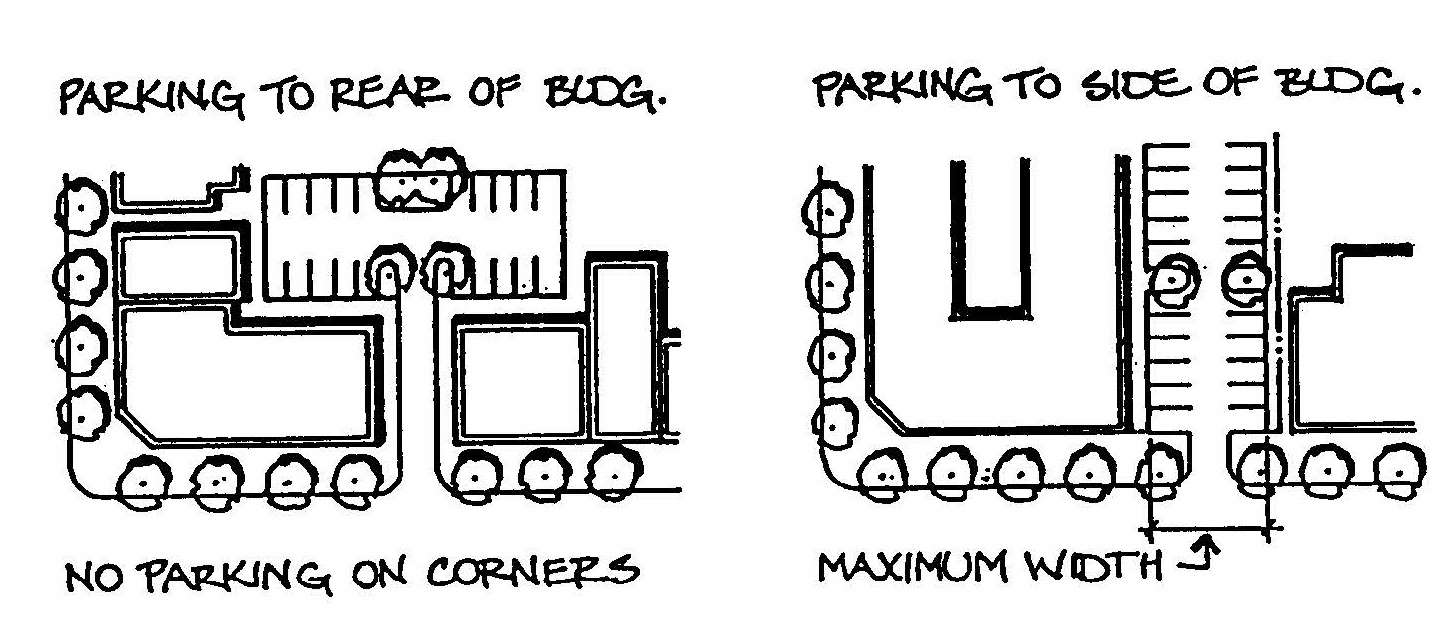
C. Pedestrian Circulation Through Parking Lots.
1. Surface parking lots containing one hundred (100) parking spaces or more shall provide pedestrian walkways through the parking field.
2. Pedestrian Walkway Locations.
a. For parking rows perpendicular to the principal building facade, pedestrian ways shall be located between two (2) rows of parking spaces at a minimum of one (1) pedestrian way every two hundred (200) feet.
b. For parking rows parallel to the principal building facade, pedestrian ways shall be incorporated adjacent to a series of aligned landscape islands at a minimum of one (1) walkway every twenty-one (21) parking spaces. Landscape island siting and design may be modified to accommodate LID BMPs.
3. Pedestrian Walkway Design.
a. Pedestrian walkways shall be raised, and shall be a minimum of five (5) feet wide, separated from vehicular travel lanes to the maximum extent possible and designed to provide safe access to nonstreetfront building entrances or existing pedestrian ways.
b. Clearly distinguish the pedestrian way network from car or transit circulation. This is particularly important in areas where these various travel modes intersect, such as at driveway entrances and in parking lots.
c. Where sidewalks or walkways cross vehicular driveways, provide a continuous raised crossing, or distinguish the crossing from the driveway surface by marking with a contrasting paving material (such as permeable pavement).
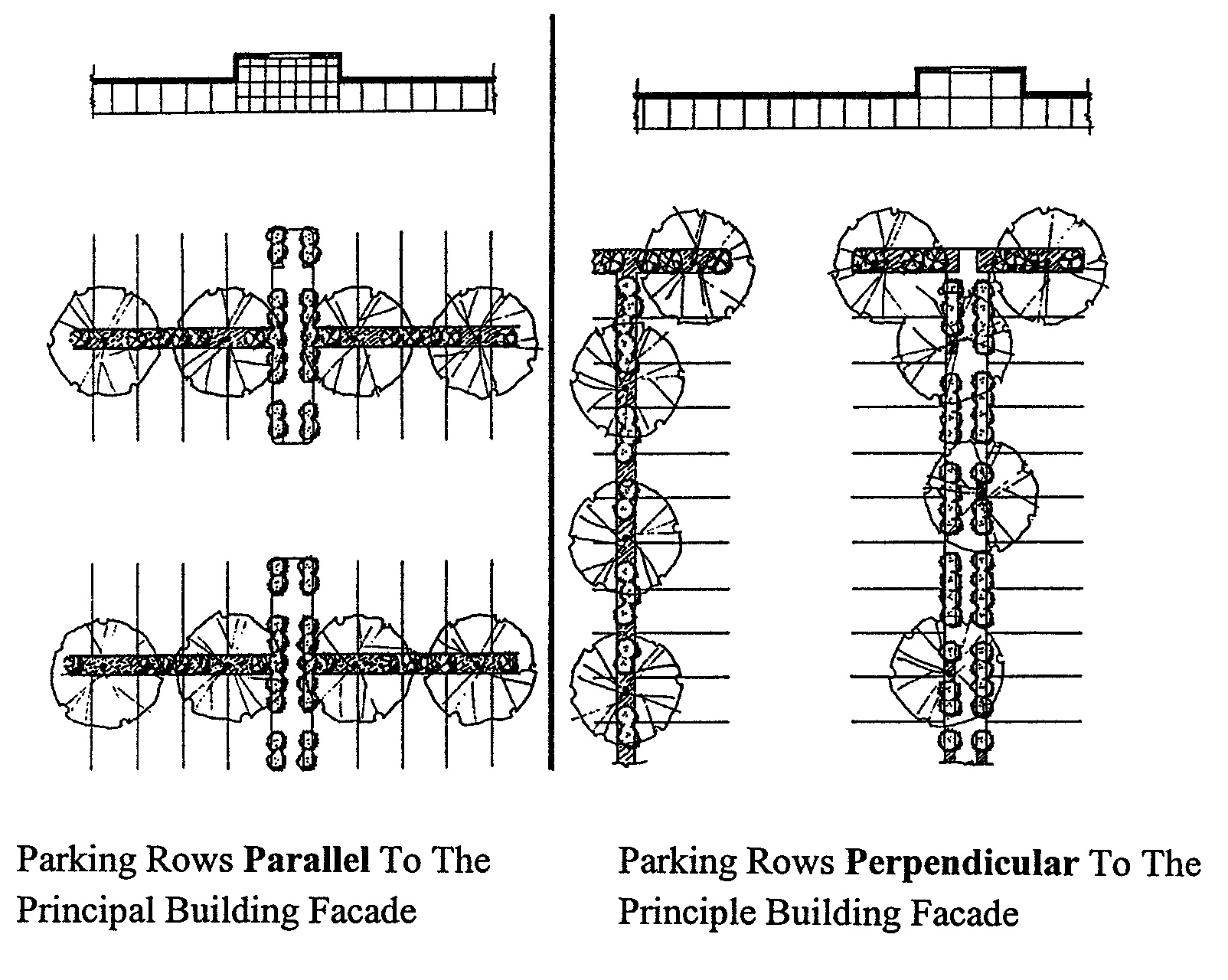
(Ord. 16-1022 § 1 (Exh. C); Ord. 15-1018 § 1)
15.300.460 Structured Parking
Purpose: Design parking structures to blend in with adjacent development. Emphasize design features that minimize the obtrusiveness of the parking use and encourage architectural compatibility with adjacent development.
A. Parking Structures with Public/Private Parking Uses. Public/private parking is only permitted within a structure. Parking structures with public/private parking uses shall comply with the following requirements:
1. Parking Stall Maximum. A parking structure containing public/private parking uses is limited to not more than one thousand two hundred (1,200) parking stalls unless additional spaces are allowed under subsection (A)(2) of this section, Parking Bonus Incentive Program for Structured Public/Private Parking.
2. Parking Bonus Incentive Program for Structured Public/Private Parking
a. A parking allowance bonus, beyond the maximum parking specified in subsection (A)(1) of this section, will be granted to those developments which provide retail/commercial, or service space beyond the requirements of subsection (B) of this section, Ground Floor Uses in Parking Structures, residential space, or a public benefit in the form of:
i. Dedicated public right-of-way, in an arrangement and amount per parcel that conforms to the City Center vehicular and pedestrian access plan; and/or
ii. Publicly accessible on-site open space greater than the minimum five percent (5%) of net site area required; and/or
iii. A public art display visible from the sidewalk or incorporated into publicly accessible on-site open space, as approved by the director.
b. Calculation of Bonus. The formula for calculating parking bonuses above maximum allowed for on-site land uses shall be as follows:
|
Retail/Commercial/Service/Residential Space |
Except for hotel uses, one (1) additional parking stall shall be awarded for each twenty-five (25) square feet of retail/commercial, service, or residential space, in addition to the minimum ground floor retail/commercial or service space required under subsection (B) of this section, Ground Floor Uses in Parking Structures, included on the same site as part of a mixed use development at the time of construction. |
|
Hotel Units |
Hotel uses shall be awarded one and one-half (1-1/2) parking space per hotel unit, in addition to the minimum ground floor retail/commercial or service space required under subsection (B) of this section, Ground Floor Uses in Parking Structures, included on the same site as part of a mixed use development at the time of construction. |
|
Dedicated Right-of-Way |
One (1) additional parking stall shall be awarded for each one hundred (100) square feet of interconnected public right-of-way dedicated according to the City Center vehicular and pedestrian access plan. |
|
Open Space |
One (1) additional parking stall shall be awarded for each fifty (50) square feet of publicly accessible on-site open space greater than the minimum five percent (5%) of net site area required. |
|
Public Art |
Up to sixty (60) additional parking stalls may be awarded for a public art display visible from the sidewalk or incorporated into publicly accessible on-site open space. To be awarded the maximum of sixty (60) stalls, the value of the public art shall be equivalent to one-half of one percent (0.5%) of the total cost of the portions of the structure containing the public/private parking uses. The director shall establish an administrative process for the consideration of public art. |
3. Location of Off-Street Parking Spaces for Non-Parking Uses. Public/private parking structures shall locate all required off-street parking spaces for any retail/commercial, service, or residential use(s) adjacent to such uses. The spaces shall be reserved and clearly designated for the customers of those uses.
4. Open Space Requirements. Except for the following, the open space requirements in SMC 15.300.300 through 15.300.340 apply to parking structures with public/private parking uses.
a. Minimum Open Space Area Required. For public/private parking structures, the minimum requirement for usable outdoor open space accessible to the public shall be equivalent to five percent (5%) of net site area.
b. Location of Open Space. Required open space shall be located at the front of a property, or to the side of the property provided it is contiguous to the required front yard open space. Exceptions shall be made for open space incorporating Bow Lake as a focal point as described in SMC 15.300.325, Incorporating Bow Lake as a Focal Point.
B. Ground Floor Uses in Parking Structures.
1. Parking structures shall be designed so that a minimum of fifty percent (50%) of the length of the exterior ground floor facade(s) facing a street provides ground floor area built out as retail/commercial or service uses as defined in SMC 15.300.730, Ground Floor Uses in Mixed Use Projects.
a. Minimum Depth. The applicable ground floor area shall extend in depth a minimum of twenty (20) feet from the exterior parking structure facade; provided, that the minimum required may be averaged, with no depth less than fifteen (15) feet.
b. Minimum Ceiling Height. The minimum clear interior ceiling height standard for the retail/commercial or service use portion of parking structures shall be thirteen (13) feet for all street level building space.
c. Fire Suppression. Parking structure ground floors shall include fire suppressing sprinkler systems at the time of construction. 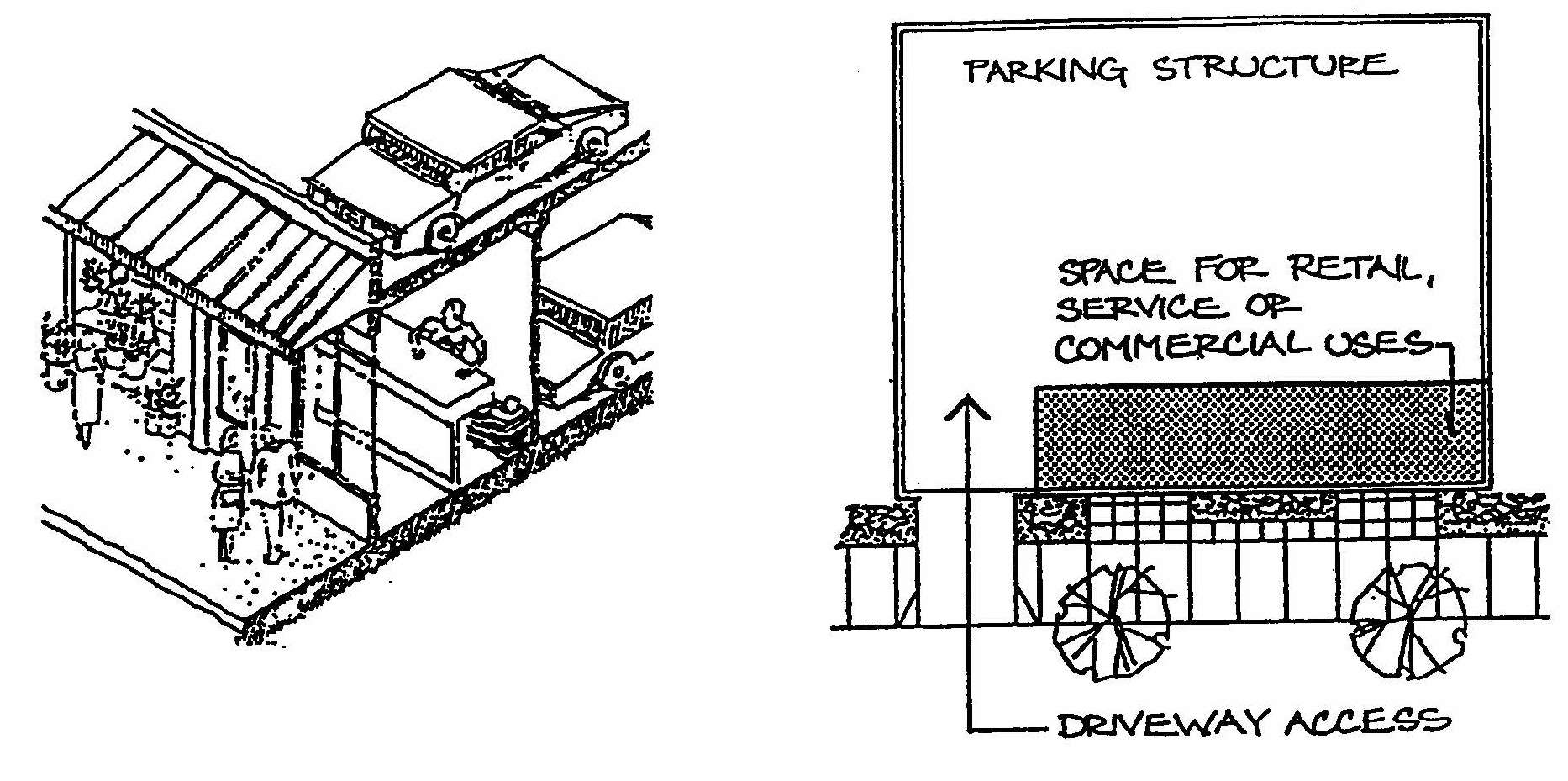
C. Parking Structure Placement and/or Setbacks.
1. Parking Structures on Properties Adjacent to International Boulevard. Except as otherwise specified below, the provisions of this subsection shall supersede the setback standards specified in SMC 15.300.210, Building Placement/Setbacks. No parking structures shall be located within thirty-five (35) feet of the International Boulevard ROW, except as specified below:
a. Parking Structures Located Behind Non-Parking Buildings. Parking structures located behind additional non-parking buildings facing International Boulevard may be located in a manner that meets developer needs, within the setback requirements (SMC 15.300.210, Building Placement/Setbacks) and other applicable building codes, except that portions of parking garages exceeding the height of fronting buildings shall meet the thirty-five (35) foot requirement specified above.
b. Parking Structures Integrated into Non-Parking Buildings. Parking structures may be integrated into buildings built within the maximum setback (SMC 15.300.210, Building Placement/Setbacks); provided, that a retail/commercial, service, office, or residential use, or a combination of these uses, comprises the building’s face for its full height on International Boulevard.
c. Corner Lots on International Boulevard. For corner lots on International Boulevard, the parking structure must be faced with other uses as specified in subsection (C)(1)(b) of this section on all sides adjacent to public and/or private streets for a distance of thirty-five (35) feet from International Boulevard.
2. Parking Structures on Properties Adjacent to All Other City Center Public and/or Private Streets. Parking structures shall be located within the maximum front yard setback, as specified in SMC 15.300.210, Building Placement/Setbacks, or built to the rear of the subject property when located behind additional buildings on site.
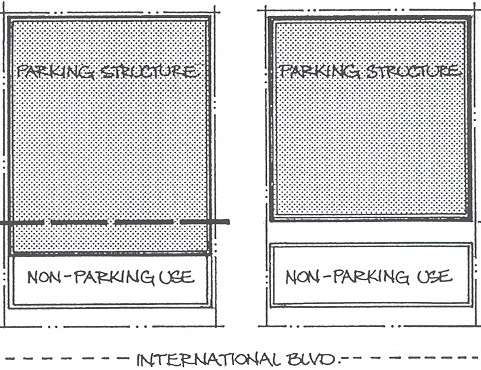
D. Parking Structure Design.
1. The following parking structure design standards shall be in addition to or, in some cases, supersede applicable design standards in other sections in this chapter, and in Chapter 15.455 SMC, Parking and Circulation.
2. Appearance and Integrated Design.
a. Parking structure facades facing or visible from the street shall have the appearance of a general commercial use in order to mask the building as a parking structure.
b. Parking structures shall be architecturally integrated or designed with an architectural theme similar to other buildings on the same site.
3. Parking Structure Character and Massing. Parking structure elevations shall incorporate vertical and horizontal variation in setback, material or fenestration design along the length of any street-facing facade.
a. Vertical Facade Changes. Intervals of architectural variation shall be incorporated at least every forty (40) feet over the length of any street-facing facade, such as:
i. Varying the arrangement, proportioning and/or design of garage floor openings;
ii. Incorporating changes in architectural materials;
iii. Projecting forward or recessing back portions or elements of the parking structure facade.
b. Horizontal Facade Changes. Parking structures shall be designed to differentiate the ground floor from upper floors, such as:
i. A horizontal projecting (or visible thickening) of the wall surface on the ground floor;
ii. Changing materials between the parking structure base and upper floors; and/or
iii. Including a continuous cornice line between the ground floor and upper floors. 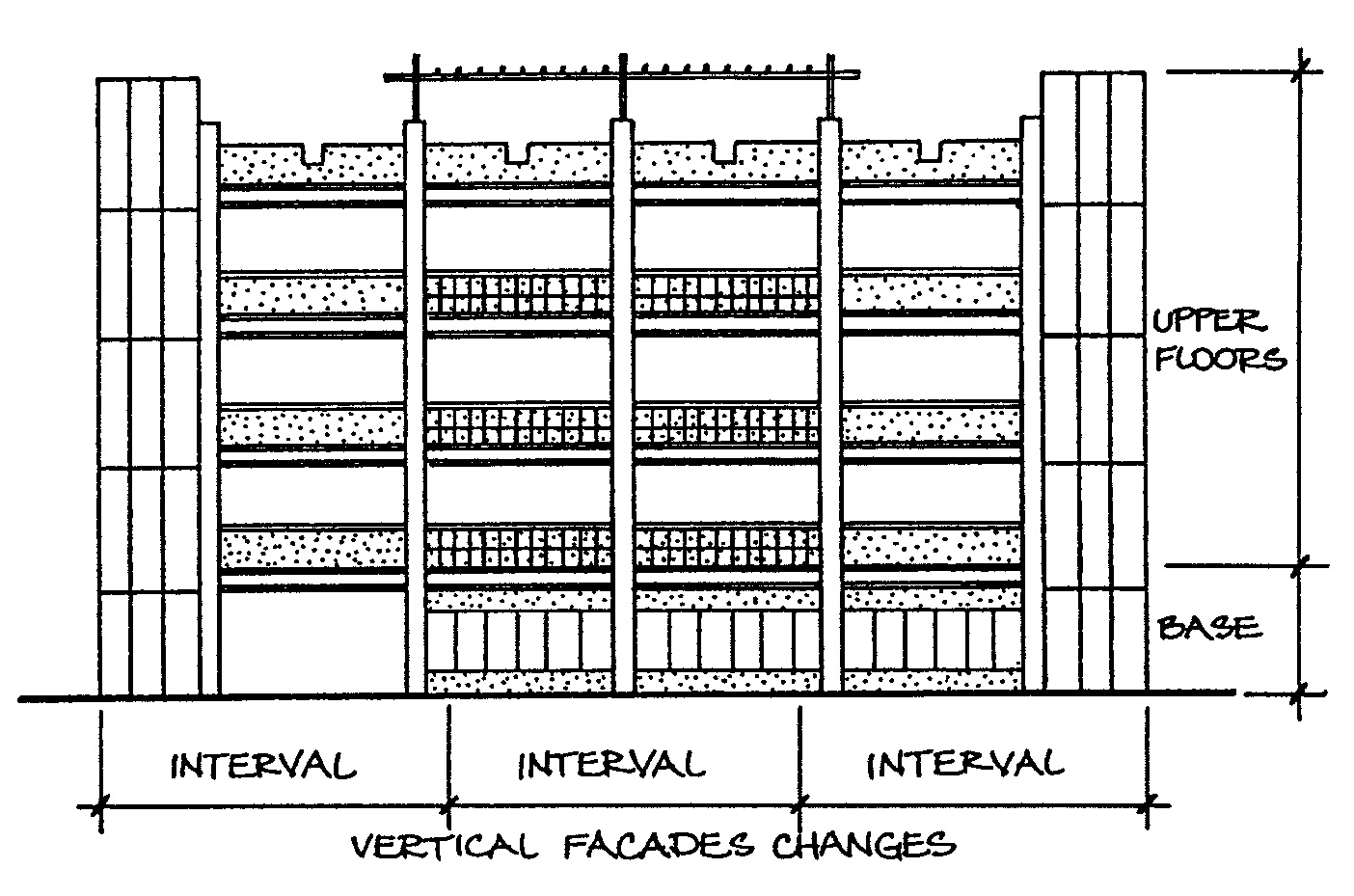
4. Parking Structure Top Floor Wall Design. Parking structure top floor wall designs must conform to one (1) or more of the following options:
a. Top Floor Wall with Architectural Focal Point. A top floor wall focal point refers to a prominent wall edge feature.
b. Top Floor Wall Line Variation.
i. Projecting Cornice. Top floor wall line articulated through a variation or step in cornice height or detail. Cornices must be located at or near the top of the wall or parapet.
ii. Articulated Parapet. Top floor wall line parapets shall incorporate angled, curved or stepped detail elements.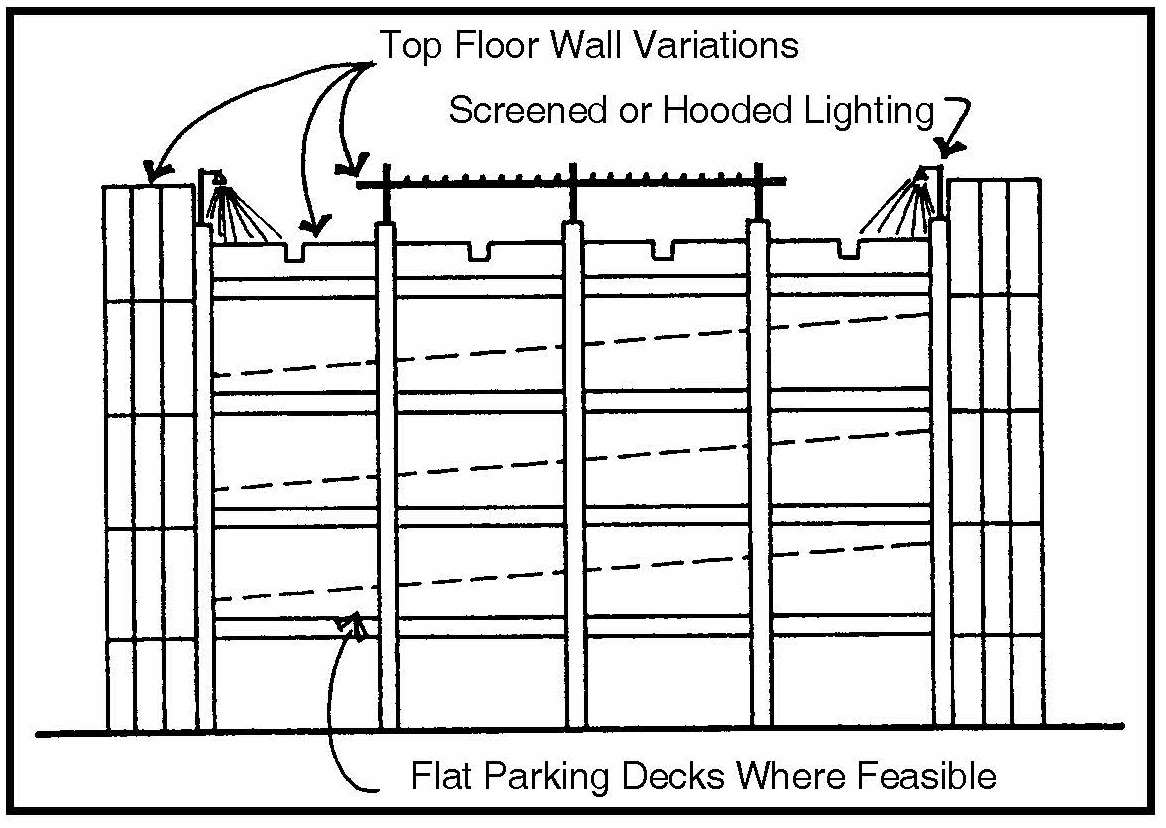
5. Parking Structure Facade Design.
a. Facades Visible from the Street. Facades of parking structures visible from a street shall be designed without continuous horizontal parking floor openings.
b. Upper Floors of Parking Structures. Minimize views into the upper floors of parking structures through one (1) or more of the following methods:
i. Screening as architectural elements on the parking structure upper floor facades; and/or
ii. Upper parking floors designed as a pattern of window-like openings on the parking structure facade.
c. Street Frontage Screening. On street frontages, ramps and decks shall be fully screened from view. This can be done with screening materials such as glazing, grilles or opaque materials.
d. Architectural Focal Points. All building facades visible from public view shall contain a focal point near the main activity areas, building entrances and building corners using at least one (1) of the following methods:
i. Unique materials;
ii. Permanent public art installations;
iii. Tower elements with rooflines that accentuate the corner;
iv. Height differentiation; and/or
v. Variation in building massing.
e. Treatment of Blank Walls. See SMC 15.300.630(B), Treatment of Blank Walls.
6. Parking Structure Ground Floor Design.
a. Street Level Design. In order to enhance building design at the street level, the following provisions shall apply: requirements for ground floor transparency and weather protection in SMC 15.300.610, Street Level Design, and building entries in SMC 15.300.620, Pedestrian Building Entries.
b. Ground Floor Screening of Parking Uses.
i. Ground Floor Areas Visible from Street. Ground floor parking areas visible from a street shall be wholly screened through any combination of walls, grilles or transparent or opaque glazing, without compromising the open parking structure requirements of the Building Code.
ii. Ground Floor Areas without Active Uses. For portions of parking structures without a ground floor retail, commercial, office, service or public use, a five (5) foot wide facade landscaping strip is required consisting of: a mix of evergreen shrub groupings spaced no more than four (4) feet apart that do not exceed a height of six (6) feet at maturity; and ground cover plantings.
7. Building Materials. A variety of building materials shall be used such as brick, stone, timber, glazing and/or metal to add visual interest to the building(s) and reduce their perceived scale. Durable materials, such as masonry, shall be used – especially near the ground level.
a. The following materials and features are prohibited:
i. Mirror glass or other highly reflective materials;
ii. Corrugated fiberglass;
iii. Chain link fencing, barbed/concertina/razor wire; and
iv. Bare or painted concrete as a predominant facade treatment.
8. Parking Floors Located under or within Buildings.
a. Parking located under or within buildings shall subordinate the garage entrance to the pedestrian entrance in terms of prominence on the street, location and design emphasis.
b. Parking at grade under a building shall be completely enclosed within the building or wholly screened through any combination of walls, decorative grilles, or other screening techniques.
9. Parking Structure Lighting.
a. In addition to the following standards, lighting of parking structures shall be provided pursuant to Chapter 17.28 SMC, Parking Structures.
b. Lighting on and/or within multi-level parking structures shall be screened, hooded or otherwise limited in illumination area so as to minimize excessive “light throw” to off-site areas. (Ord. 17-1008 § 1 (Exh. A); Ord. 15-1018 § 1)
15.300.500 Landscaping Standards
A. In addition to the standards of this section and chapter, landscaping requirements shall be provided pursuant to Chapter 15.445 SMC, Landscaping and Tree Retention.
B. Surface Parking Lot Landscaping and Treatment of Perimeter.
1. At least ten percent (10%) of the interior surface parking area shall have landscaping when the total number exceeds twenty (20) parking stalls, including a minimum of one (1) tree for every seven (7) parking stalls to be distributed between rows and/or stalls throughout the parking lot.
2. Surface parking shall be visually screened from public and/or private streets by means of building placement and/or landscaping. The perimeter of a parking lot shall be planted with five (5) feet of Type III landscaping, or if site layout requires, a maximum four (4) foot high fence and sufficient landscaping to filter views. Any abutting landscaped areas can be credited toward meeting this standard.
3. The required width dimension for interior parking area planting beds shall be a measurement of the usable soil area between pavement curb edges. Except as noted in this subsection, trees and required landscaping shall be placed in planting beds at least five (5) feet wide between parking rows and/or stalls within the interior of the parking lot.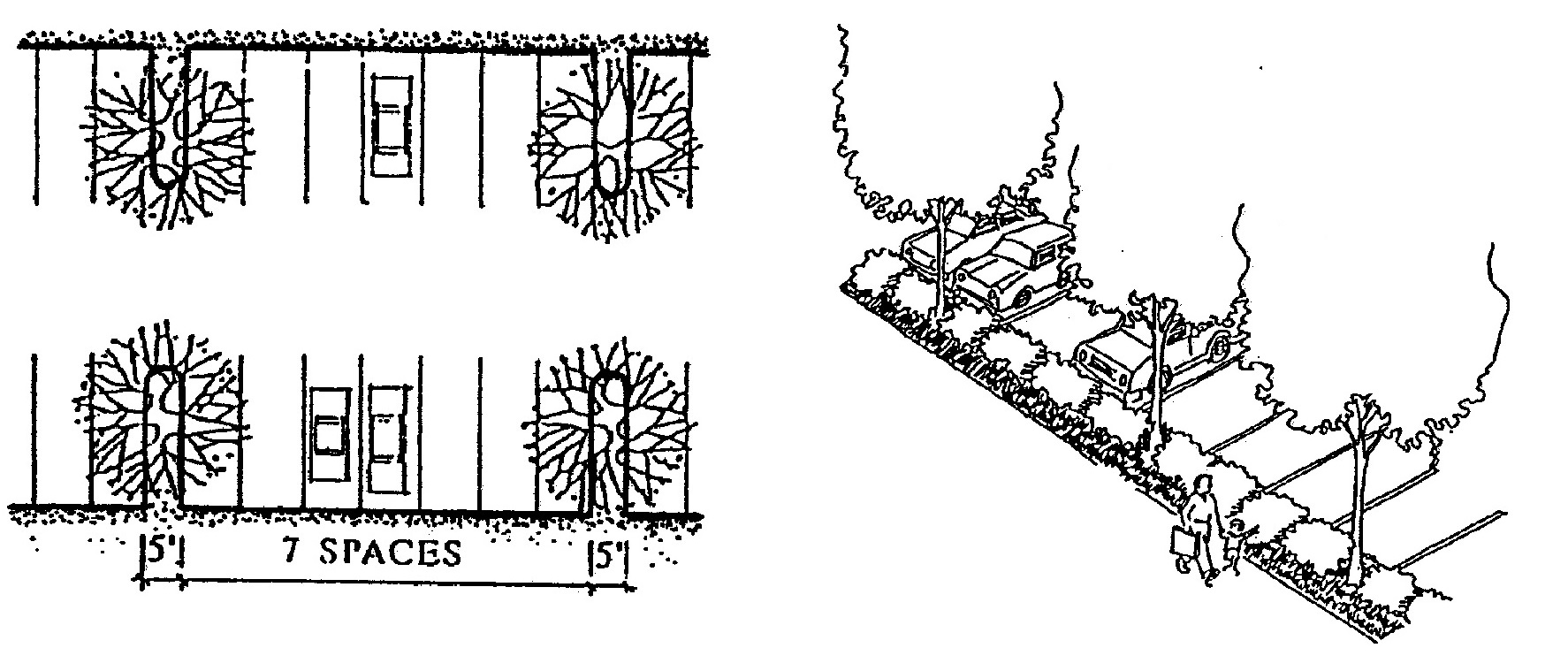
(Ord. 15-1018 § 1)
15.300.600 Building Design
Purpose: Buildings should be designed to promote an architecturally appealing environment. Design emphasis should be given to the pedestrian through the provision of inviting building entries, street-level amenities and other structural and facade elements to encourage pedestrian interaction. (Ord. 15-1018 § 1)
15.300.610 Street Level Design
A. Ground Floor Transparency Requirements.
1. Windows shall be provided on the street level rather than blank walls to encourage a visual link between the business and passing pedestrians.
2. Transparency requirements shall apply to buildings with a ground floor retail/commercial or service use, as defined in SMC 15.300.730 and in the City Center Use Charts (SMC 15.300.050 through 15.300.055), including portions of buildings where ground floor uses are convertible to a retail/commercial or service use. Transparency requirements shall not apply to portions of a building with ground floor housing.
a. Windows shall cover at least sixty percent (60%) of the public street facing ground floor building wall area.
3. Transparency Design Requirements.
a. Transparency requirements shall apply to that area of the ground floor building wall fronting the street up to the finished ceiling height of the first floor building space.
b. Windows shall begin twelve (12) to thirty (30) inches above the finished grade of the first floor building space.
c. At the first floor building level, darkly tinted, mirrored or reflective glass shall not be used. Lightly tinted windows are allowed for nonretail ground floor uses.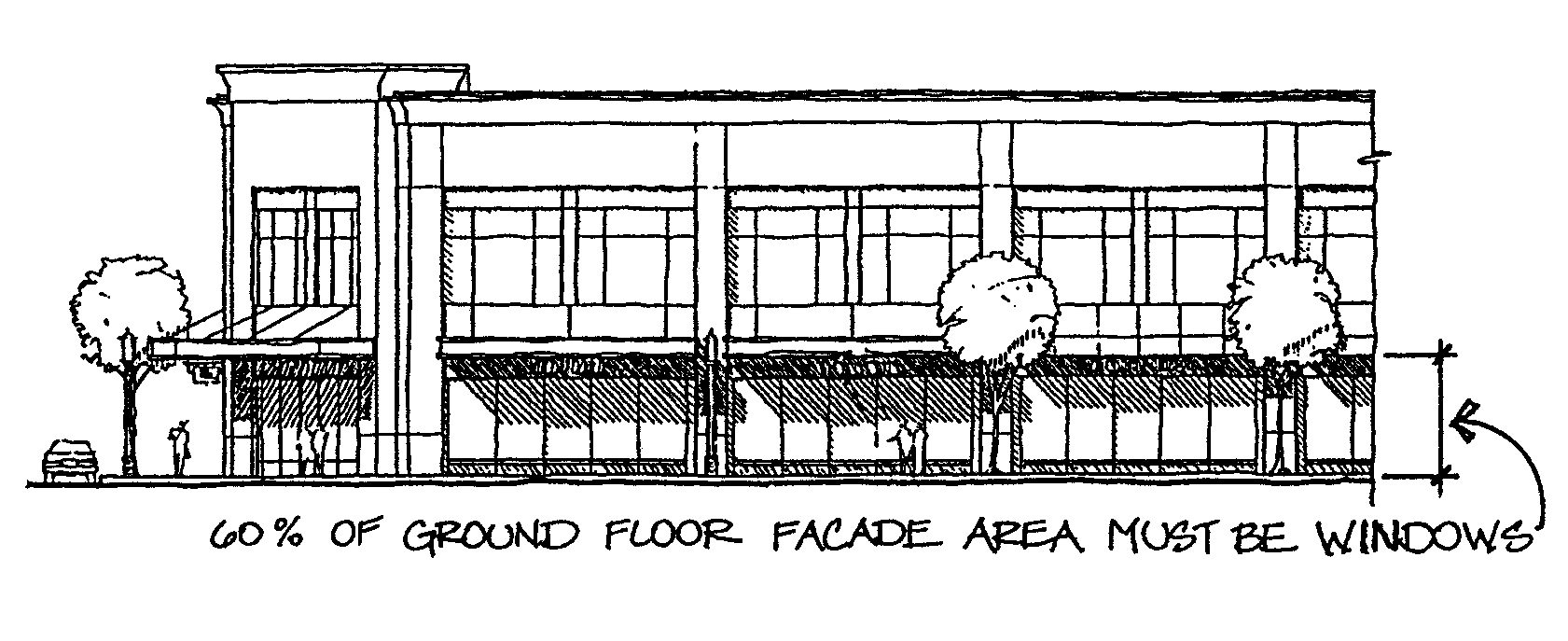
B. Pedestrian Weather Protection Along Building Facades.
1. Building facades with ground floor retail/commercial or service uses shall be designed to provide for pedestrian weather protection through the use of awnings, canopies, colonnades, marquees, or building overhangs.
2. Pedestrian Weather Protection Structure Design.
a. Length. Pedestrian weather protection structures shall extend along at least the length of the street-facing facade with the ground floor retail/commercial or service use.
b. Width. Pedestrian weather protection structures shall extend a minimum of four (4) feet out from the building facade. The maximum horizontal projection from the surface of the building shall be eight (8) feet or seventy-five percent (75%) of the distance to the curb face, whichever is less. Pedestrian weather protection structures shall be architecturally integrated with the ground level design of the building to which they are attached.
c. Height. The minimum height of pedestrian weather protection structures shall be eight (8) feet and six (6) inches above the sidewalk surface. Maintain a horizontal consistency by aligning the bottom edge of weather protection structures with those on adjacent buildings. Where the grade is sloping, maintain the average height above grade of adjacent weather protection structures.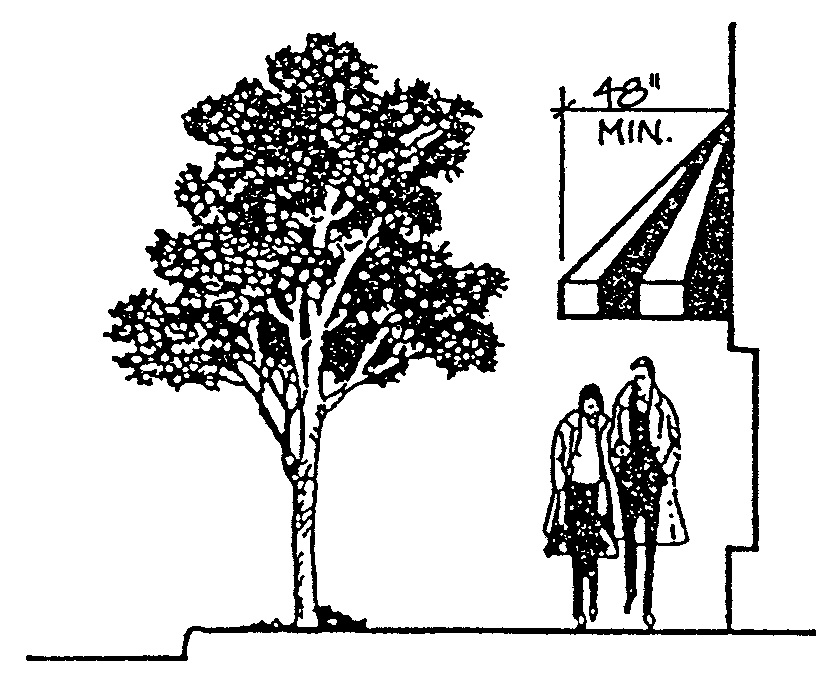
3. Pedestrian Weather Protection and Building Facade Landscaping. Building facade landscaping shall not be required under pedestrian weather protection structures along public or private street frontages. Any facade landscaping provided under pedestrian weather protection structures shall be of such width that a minimum four (4) feet of unobstructed walking area remains under the building awning, canopy, overhang, or other weather protection structure.
a. Building facade landscaping (Type V landscaping) in front of a ground floor retail use shall be designed and maintained to avoid obscuring visibility of street-facing windows or limiting access to building entrances. (Ord. 16-1022 § 1 (Exh. C); Ord. 15-1018 § 1)
15.300.620 Pedestrian Building Entries
A. Primary Building Entries. Primary building entries shall be designed to be clearly visible or recognizable from an adjacent public or private street through the incorporation of two (2) or more of the following features:
1. Canopies, awnings, or other entry coverings that provide pedestrian shelter and interest;
2. Distinctive architectural elements such as a variation in the building footprint, roof form, or amount of transparent glazing;
3. Pedestrian-scaled ornamental lighting no greater than sixteen (16) feet in height;
4. Landscaping designed as entry focal point.
B. Ground Level Building Entries. All ground level building entries shall be located no more than three (3) feet above or below the grade of the sidewalk. In the case of an allowable grade difference between a building entry and adjoining sidewalk, provide stairs and/or ramps to accommodate pedestrian access.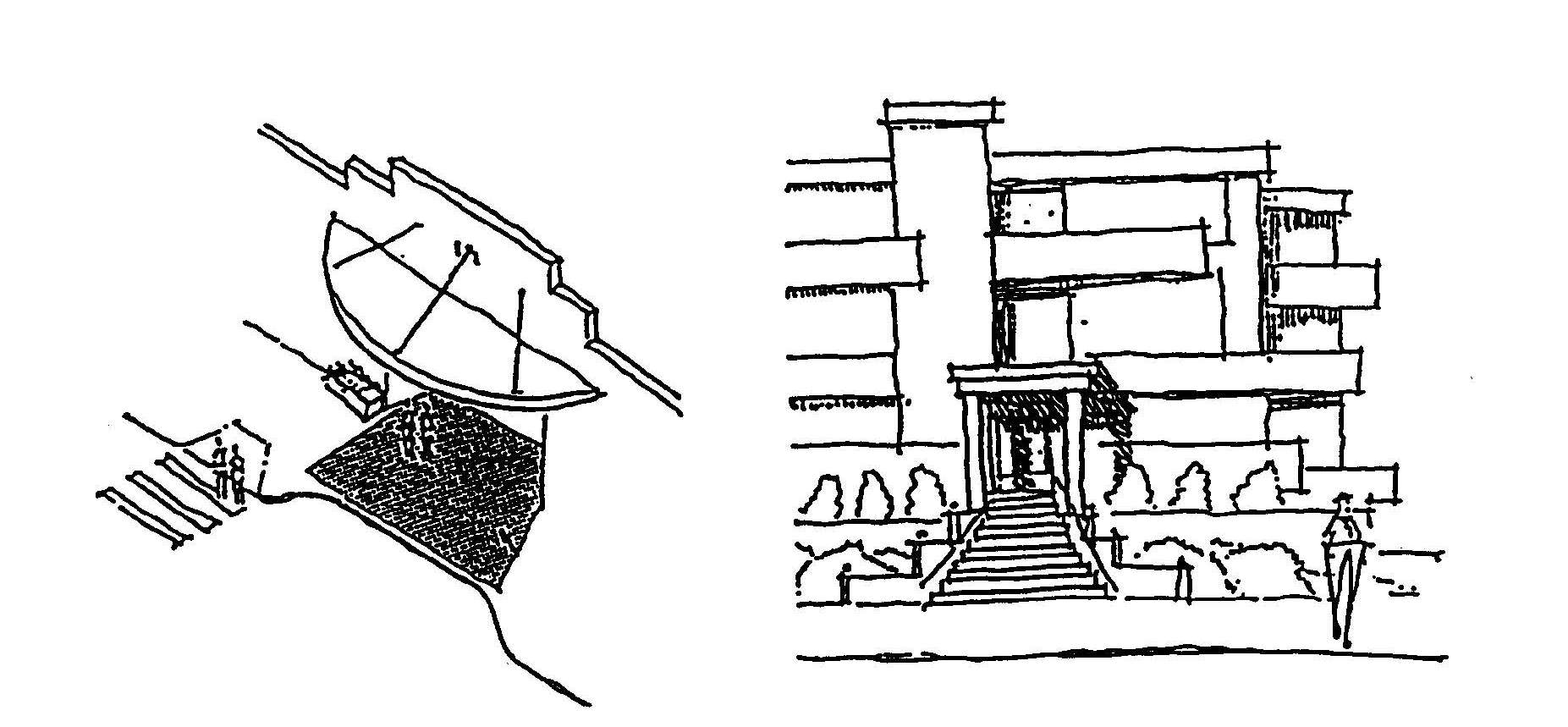
(Ord. 15-1018 § 1)
15.300.630 Building Facades
A. Character and Massing.
1. Building facades one hundred (100) feet or greater in length shall incorporate vertical and/or horizontal variations in setback, material or fenestration design along the length of the applicable facade, in at least two (2) of the following ways listed below (see City Center Overlay District parking structure standards in Chapter 15.455 SMC, Parking and Circulation, for character and massing requirements specific to parking structures):
a. Vertical Facade Changes. Incorporate intervals of architectural variation at least every eighty (80) feet over the length of the applicable facade, such as:
i. Varying the arrangement, proportioning and/or design of windows and doors;
ii. Incorporating changes in architectural materials; and/or
iii. Projecting forward or recessing back portions or elements of the applicable facade. Front facades incorporating a variation in building setback shall include within the setback such architectural elements as covered or recessed building entries, plazas or courtyards, storefront or bay windows, seating and/or planting areas.
b. Horizontal Facade Changes. Designed to differentiate the ground floor from upper floors, such as:
i. Stepping back the upper floors from the ground floor building facade;
ii. Changing materials between the building base and upper floors;
iii. Including a continuous cornice line or pedestrian weather protection element between the ground floor and upper floors.
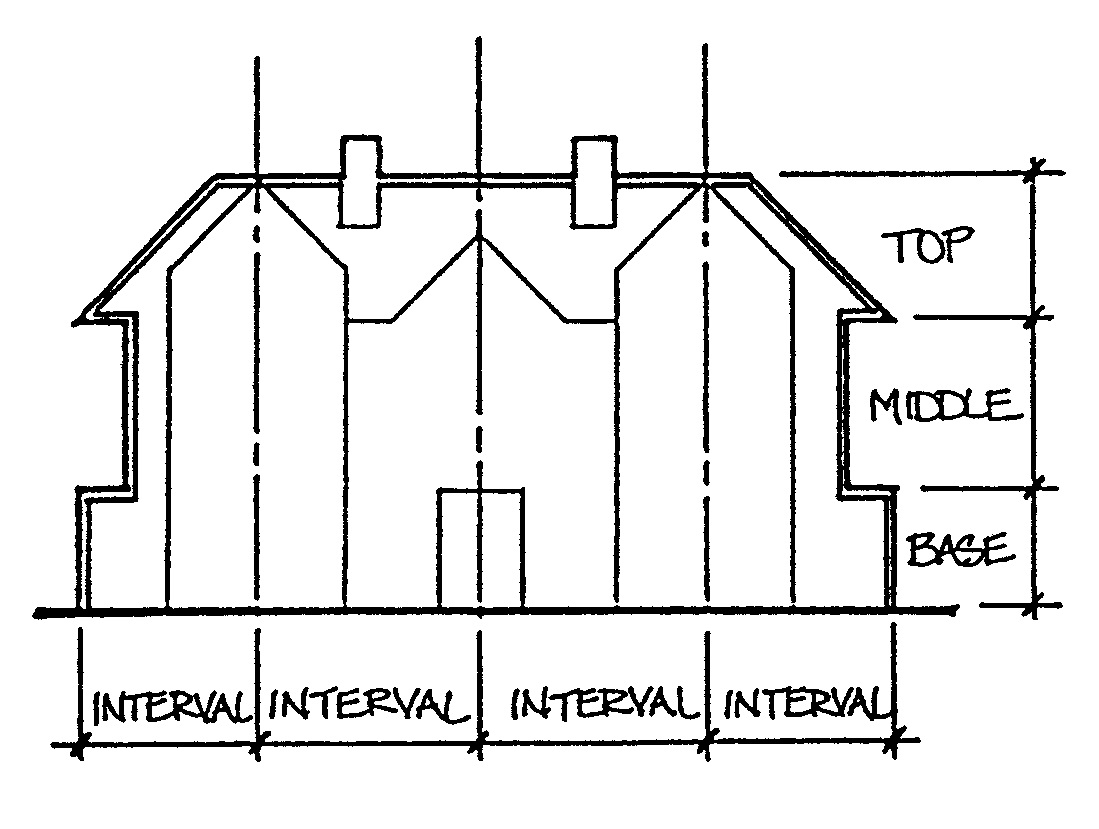
B. Treatment of Blank Walls.
1. Definition. The definition of a “blank wall” is any wall or portion of a wall that is located within forty (40) feet of a street or pedestrian-only corridor and is without a ground level window, door or facade opening along any street-facing facade section of twenty (20) feet in length or more.
2. Where blank wall sections are unavoidable due to the requirements of a particular land use or structural needs, they shall not exceed a length of fifty (50) feet, or twenty percent (20%) of the length of the street-facing facade, whichever is less.
3. Design Treatments. Blank wall sections of allowed lengths shall receive one (1) or more of the following special design treatments up to at least the finished ceiling height of the first floor building space in order to increase pedestrian comfort and interest:
a. Install vertical trellis in front of the wall with climbing vines or other plant materials over at least thirty percent (30%) of the blank wall surface;
b. Provide a decorative masonry pattern, or other architectural feature as approved by the Director, over at least thirty percent (30%) of the blank wall surface; and/or
c. Employ small setbacks, projections, indentations, or intervals of material change to break up the wall’s surface. 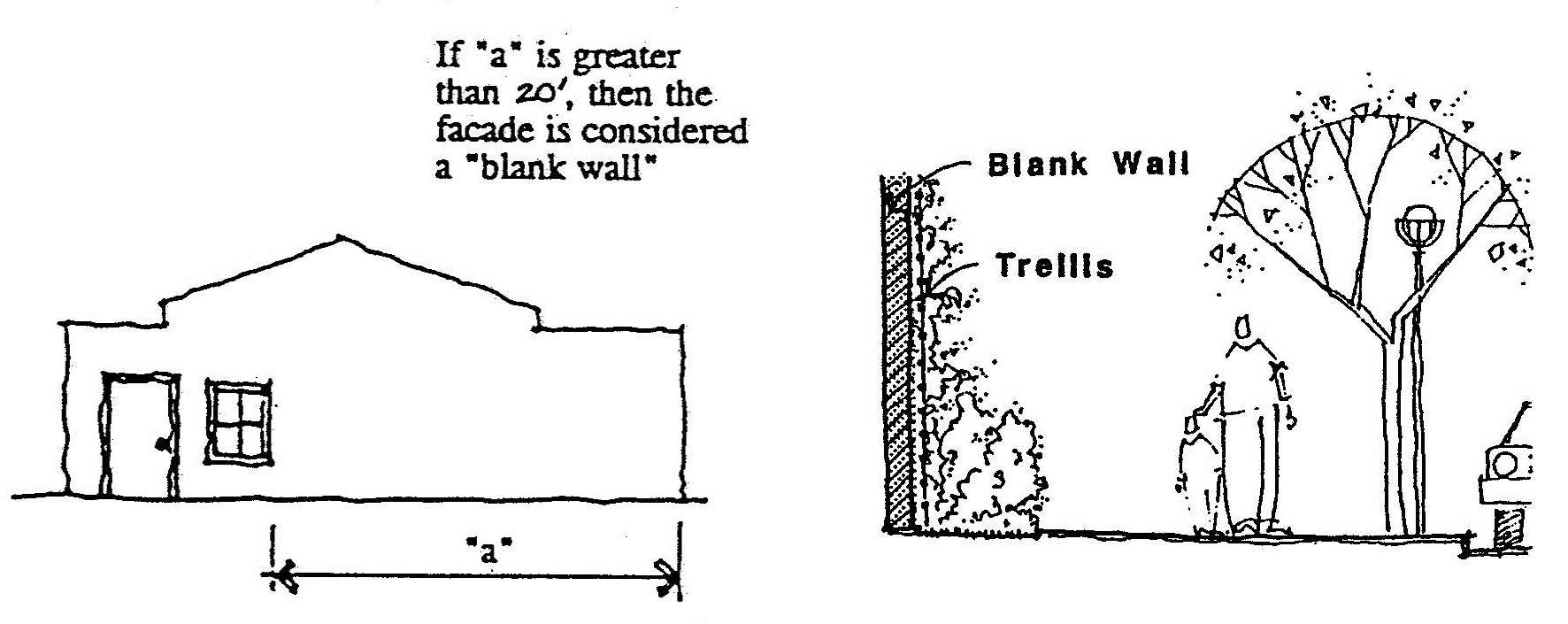
(Ord. 15-1018 § 1)
15.300.640 Rooflines and Equipment
A. Rooflines. In order to provide a visual terminus to the tops of City Center Overlay District buildings and soften rectilinear forms, roof designs must conform to one (1) of the following options:
1. Roofline with Architectural Focal Point. A roofline focal point refers to a prominent rooftop feature such as a peak, tower, gable, dome, barrel vault or roofline trellis structure.
2. Roofline Variation. The roofline articulated through a variation or step in roof height or detail, such as:
a. Projecting Cornice. Roofline articulated through a variation or step in cornice height or detail. Cornices must be located at or near the top of the wall or parapet.
b. Articulated Parapet. Roofline parapets shall incorporate angled, curved or stepped detail elements.
3. Pitched Roof or Full Mansard. A roof with angled edges, with or without a defined ridge line and extended eaves.
4. Terraced Roof. A roofline incorporating setbacks for balconies, roof gardens, or patios.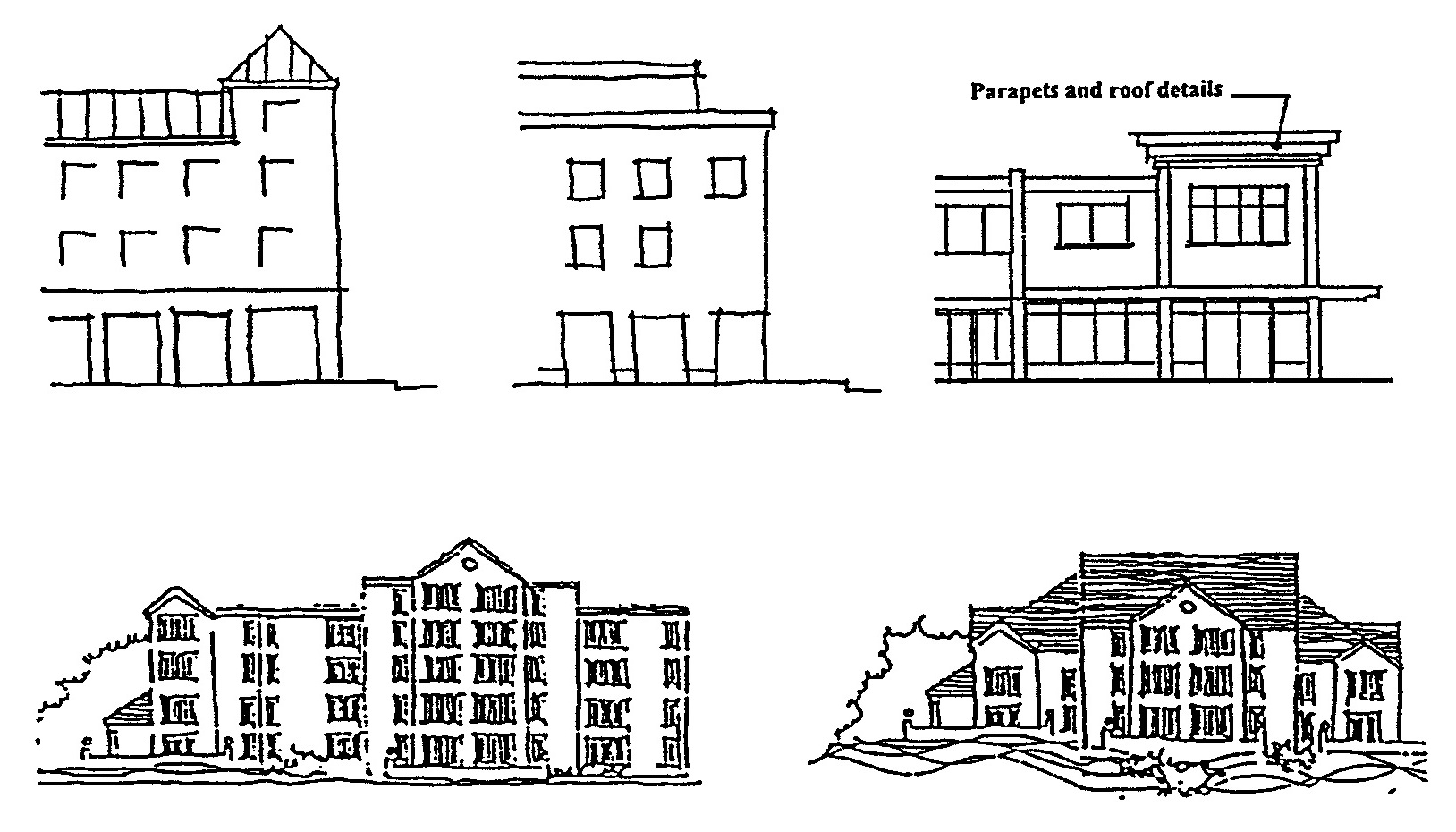
B. Rooftop Equipment. Building rooftops shall be designed to effectively screen mechanical equipment from street-level view through one (1) or more of the following methods:
1. A concealing roofline;
2. A terraced facade;
3. A screening wall or grillwork directly surrounding the equipment;
4. Sufficient setback from the facade edge to be concealed from ground level view;
5. Vegetated roof designed in accordance with the Surface Water Design Manual and applicable building codes.
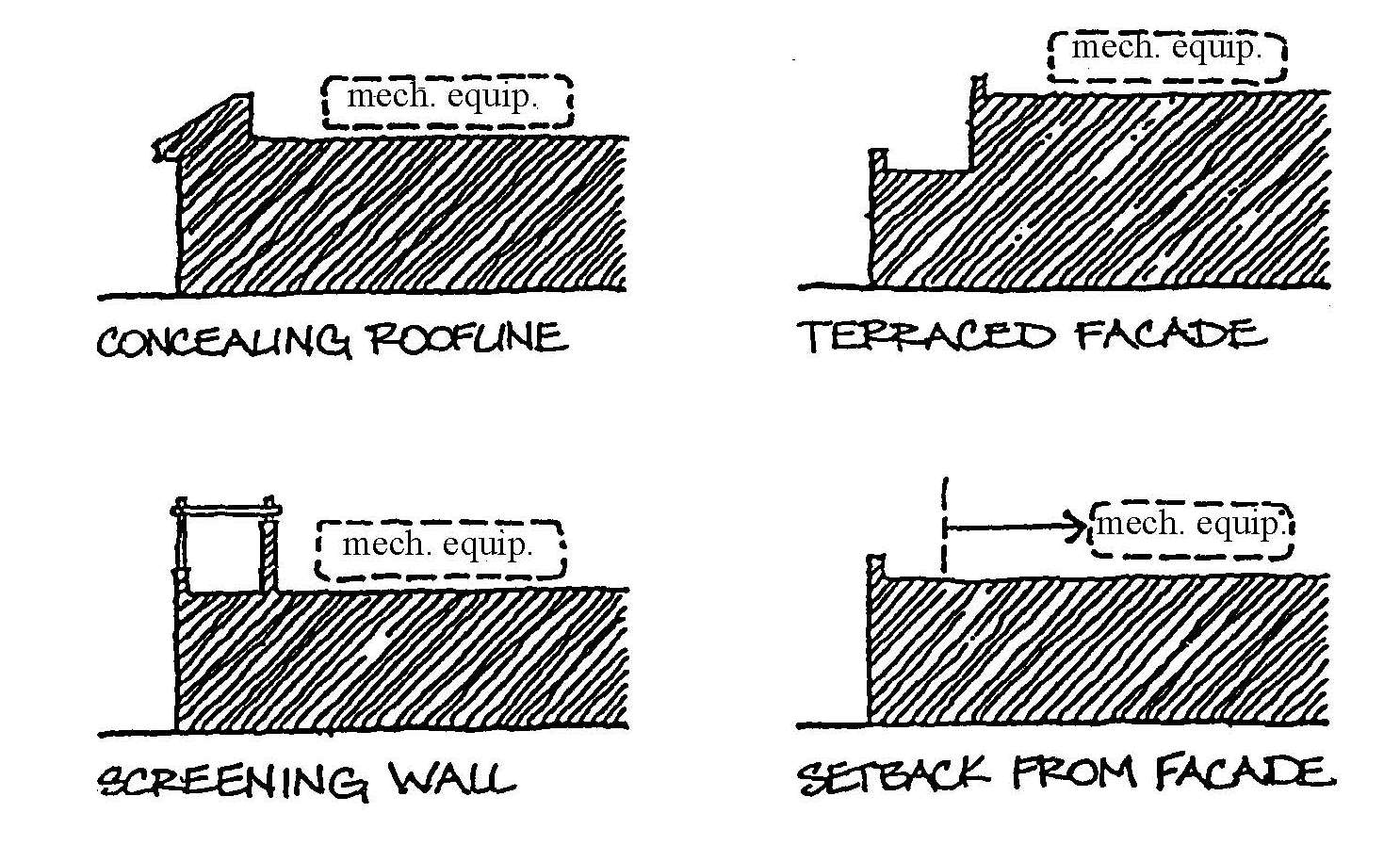
(Ord. 16-1022 § 1 (Exh. C); Ord. 15-1018 § 1)
15.300.700 Mixed Use and Multi-Family Development Standards
(Ord. 15-1018 § 1)
15.300.710 Mixed Use Development Standards
Purpose: Incorporate a mixture of different types of uses in one (1) structure or in close proximity to encourage pedestrian circulation, maximize site development potential and create an active environment. Design ground floors to accommodate commercial uses that benefit from a high degree of pedestrian activity while upper floors should be devoted to residential uses. The following regulations shall supersede the mixed use standard in SMC 15.520.300, Residential Mixed Use Standards, and shall apply to City Center developments proposing land uses specified as being part of a mixed use development in SMC 15.300.055, City Center Overlay District Use Chart. (Ord. 15-1018 § 1)
15.300.720 Definition of Mixed Use
Mixed use refers to the combining of retail/commercial and/or service uses with residential or office use in the same building or on the same site in one (1) of the following ways:
A. Vertical Mixed Use. A single structure with the above floors used for residential or office use and a portion of the ground floor for retail/commercial or service uses.
B. Horizontal Mixed Use – Attached. A single structure which provides retail/commercial or service use in the portion fronting the public or private street with attached residential or office uses behind.
C. Horizontal Mixed Use – Detached. Two (2) or more structures on one (1) site which provide retail/commercial or service uses in the structure(s) fronting the public or private street, and residential or office uses in separate structure(s) behind or to the side.
|
|
|
(Ord. 15-1018 § 1)
15.300.730 Ground Floor Uses in Mixed Use Projects
The following shall apply to vertically mixed use buildings, as well as structures in horizontal mixed use projects sited within the maximum front yard setback (see SMC 15.300.720, Definition of Mixed Use, for definitions of mixed use types):
A. Minimum Ground Floor Use Requirements. A minimum of fifty percent (50%) of the length of the exterior ground floor facing the street(s), excluding vehicle entrances, exits, and alleys, shall be designed to be occupied by a retail/commercial or service use on street frontages identified in Figure 15.300.730A.
Figure 15.300.730A: Required Ground Floor Uses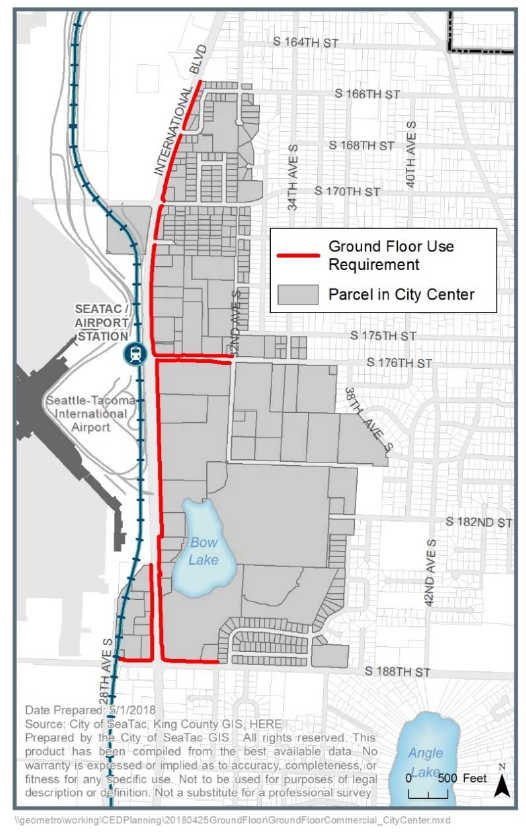
B. Permitted Retail/Commercial/Service Uses. A partial list of permitted retail/commercial or service uses is specified below (for a detailed listing of permitted uses, refer to the City Center use charts):
1. Retail/Commercial. Retail/commercial uses such as retail food shops, groceries, drug stores, florists, apparel and specialty shops, hotels/motels, restaurants, and other retail/commercial uses that are not specifically auto-oriented in scale or nature.
2. Services. General offices, such as professional, financial, insurance and real estate services; or personal services, such as beauty salons, dry cleaners, shoe repair shops, banks, health and social services, libraries and health clubs.
C. Design Requirements.
1. Depth. The leasable ground floor area shall extend in depth a minimum of thirty (30) feet from the exterior building facade; provided, that the minimum required may be averaged, with no depth less than fifteen (15) feet.
2. Ceiling Heights. The minimum clear interior ceiling height standard for the retail/commercial or service use portion of mixed use buildings shall be a minimum ten (10) feet for all street level building space.
3. Architecture and Entrances. Pedestrian-level commercial uses in vertical mixed use projects shall be distinguished architecturally from attached residential units and shall utilize separate entrances where feasible.
D. Signs. Ground floor businesses shall provide business identity signs that fit with the architectural character of the site and shall conform to all other applicable sign requirements identified in the SeaTac Municipal Code.
E. Ground Floor Uses in Parking Structures. For ground floor use requirements relative to parking structures, see SMC 15.300.460(B), Ground Floor Uses in Parking Structures.
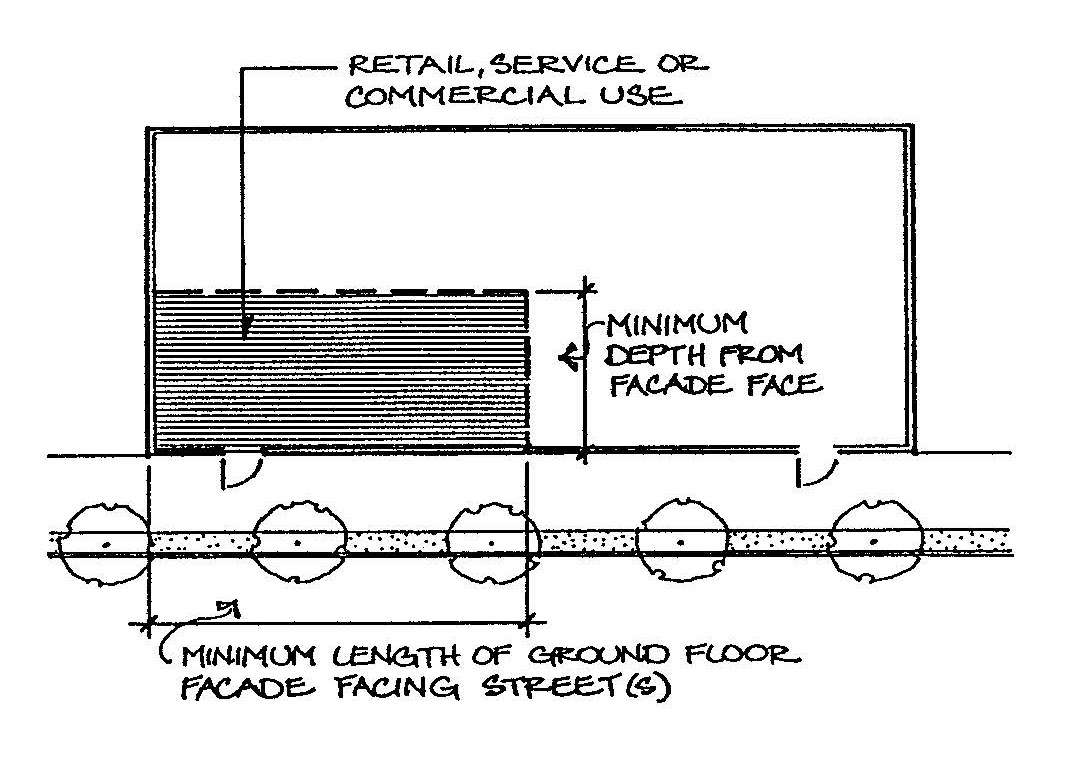
(Ord. 18-1019 § 2; Ord. 15-1018 § 1)
15.300.740 Multi-Family Development Standards
Purpose: Design multiple-family units that are of high quality, good architectural design, are compatible with adjacent development, especially single-family neighborhoods, and that provide linked open space.
A. Multi-family and residential mixed use development within the City Center Overlay District shall meet the requirements of Chapter 15.510 SMC, Multi-Family Housing Design Standards. (Ord. 18-1029 § 1; Ord. 15-1018 § 1)
15.300.800 Additional Standards
(Ord. 15-1018 § 1)
15.300.810 Fences
A. Fences over four (4) feet in height or other features that form continuous visual barriers or block views to the windows of a ground level retail/commercial or service use are prohibited within the front yard setback zone.
B. Single- and Multi-Family Dwellings. Single-family and multi-family dwelling units, excluding residential mixed use structures within the City Center, may have fences to a height of six (6) feet when fronting on a major arterial/highway, but must have adequate setback in order to maintain sight distance requirements established in SMC 15.400.350. (Ord. 15-1018 § 1)
15.300.820 Signs
Monument signs shall be located according to an approved site plan and in a manner that does not obstruct pedestrian movement. (Ord. 15-1018 § 1)
15.300.900 Development Incentives
In addition to the following, incentives in Chapter 15.425 SMC, Development Incentives, may apply. (Ord. 15-1018 § 1)
15.300.950 Parking Bonus Incentive Program for Structured Public/Private Parking
Repealed by Ord. 17-1008. (Ord. 15-1018 § 1)



